7.2 Review of Anatomy and Physiology of the Endocrine System
Open Resources for Nursing (Open RN)
The endocrine system includes several glands, including the pineal, hypothalamus, pituitary, thyroid, parathyroid, and adrenal glands, as well as the pancreas, ovaries, and testes. See Figure 7.1 for an illustration of these organs of the endocrine system.[1]
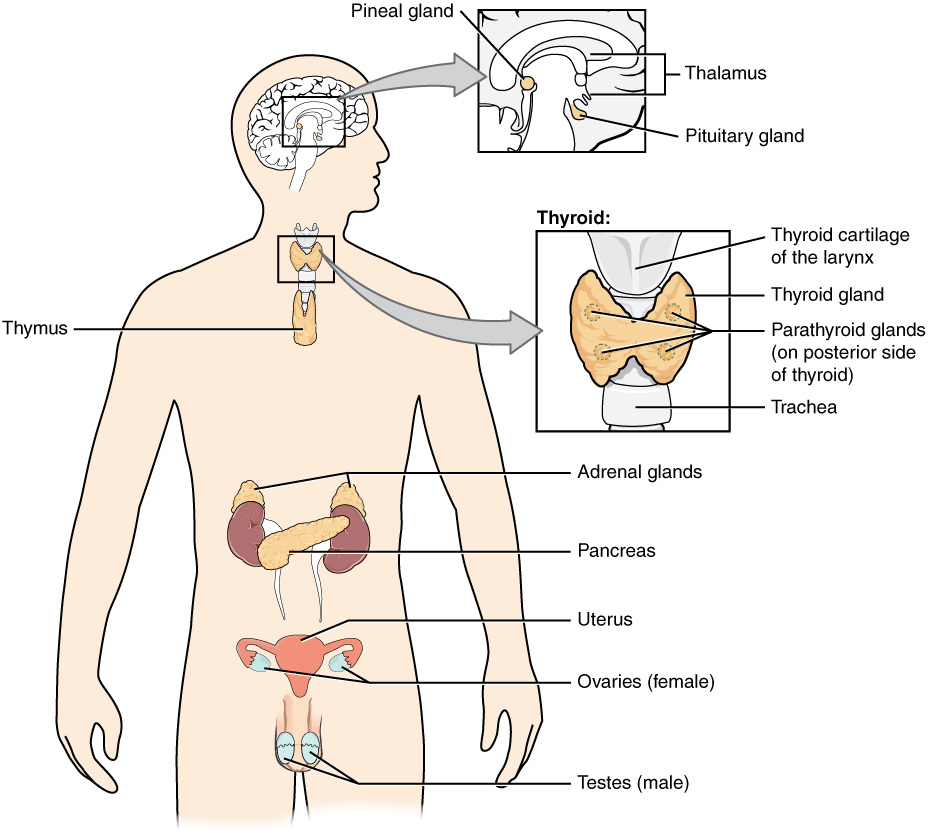
Endocrine glands secrete hormones as chemical signaling. Hormones are transported via the bloodstream throughout the body, where they bind to receptors on target cells, triggering a characteristic response. This long-distance communication is the fundamental function of the endocrine system.
Pineal Gland
The pineal gland is a small cone-shaped structure that extends posteriorly from a ventricle of the brain. The pineal gland produces the hormone melatonin and secretes it directly into the cerebrospinal fluid, which carries it into the blood. Melatonin affects reproductive development and daily circadian rhythms.[2]
Thymus Gland
The thymus gland is located in the mediastinum. It is responsible for production of T lymphocytes for the body’s immune response.
Hypothalamus and Pituitary
The hypothalamus can be viewed as the body’s control center. The hypothalamus connects to the pituitary gland by the stalk-like infundibulum. The pituitary gland is about the size of a pea and consists of an anterior and posterior lobe. Each secretes different hormones in response to signals from the hypothalamus. See Figure 7.2 for an illustration of the hypothalamus–pituitary complex.[3]
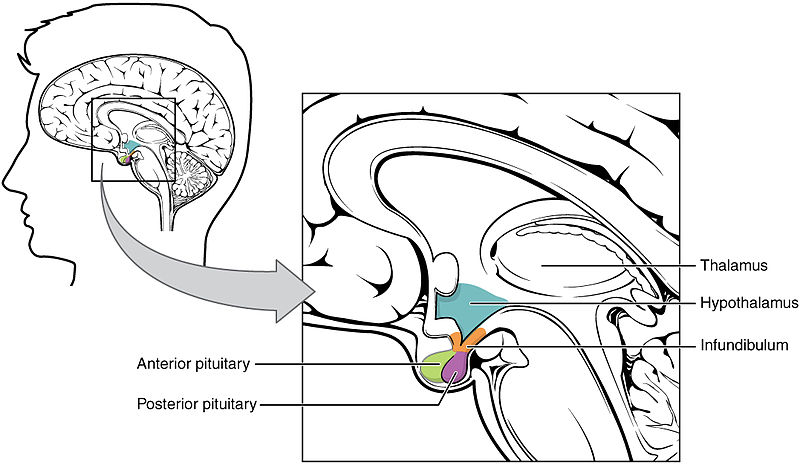
The hypothalamus–pituitary complex releases hormones that stimulate secretion of other hormones by other endocrine glands and also produce direct responses in target tissues. Its main function is to maintain a stable state called homeostasis. See Figure 7.3[4] for an illustration of the effects of the hormones released by the anterior and posterior pituitary glands.

Posterior Pituitary
The posterior pituitary gland secretes two hormones produced by the hypothalamus called oxytocin and antidiuretic hormone (ADH).
- Oxytocin stimulates labor contractions and lactation after delivery.
- Antidiuretic hormone (ADH) regulates blood osmolarity by targeting the kidneys to increase water reabsorption.
Blood osmolarity refers to the concentration of sodium and other solutes in the blood. Blood osmolarity levels change in response to fluid intake, salty food ingestion, head injuries, disease, and side effects of medications. Blood osmolarity is constantly monitored by osmoreceptors in the hypothalamus.
As blood osmolarity increases beyond normal levels, the posterior pituitary is stimulated to release ADH. For example, high blood osmolarity can occur if someone eats a very salty meal or becomes dehydrated from inadequate intake of fluids. Osmoreceptors sense the high blood osmolarity and trigger the sensation of thirst, while also stimulating the posterior pituitary to release ADH. ADH targets the kidneys to increase water reabsorption. As more water is reabsorbed by the kidneys and is returned to the blood, blood osmolarity decreases.
In contrast, if blood osmolarity decreases beyond normal levels, the release of ADH is inhibited, causing the kidney to increase the elimination of water and resulting in dilute urine.
Drugs can also affect the secretion of ADH or imitate its effects. For example, alcohol consumption inhibits the release of ADH, resulting in increased dilute urine production that can eventually lead to dehydration (and a hangover). Another example is vasopressin, a synthetic ADH medication that is used to treat very low blood pressure by causing the kidneys to retain water. Vasopressin is also used to treat a disease called diabetes insipidus (DI). People with DI have decreased amounts of ADH released by their pituitary, resulting in excessive amounts of dilute urine and severe dehydration.[5]
Anterior Pituitary
The anterior pituitary produces seven hormones:
- Growth hormone (GH): Promotes growth in children, helps maintain normal body structure in adults, and plays a role in metabolism in both children and adults.
- Thyroid-stimulating hormone (TSH): Stimulates thyroid hormone release by the thyroid gland. For example, if thyroid hormone levels in the blood are too low, the pituitary gland makes larger amounts of TSH to tell the thyroid to work harder. Conversely, if thyroid hormone levels are too high, the pituitary gland releases little or no TSH.
- Adrenocorticotropic hormone (ACTH): Regulates the release of glucocorticoid hormone (cortisol) by the adrenal gland.
- Follicle-stimulating hormone (FSH): Plays a role in sexual development and reproduction by affecting the function of the ovaries and testes.
- Luteinizing hormone (LH): Plays a role in sexual development in children and in women and triggers ovulation (the release of an egg from the ovary) during the menstrual cycle.
- Beta-endorphin: Possesses morphine-like effects and plays a role in pain management and natural reward circuits such as feeding, drinking, sex, and maternal behavior.
- Prolactin: Stimulates breast development and milk production in females.
Of the hormones released by the anterior pituitary, TSH, ACTH, FSH, and LH are referred to as tropic hormones because they turn on or off the function of other endocrine glands.
Negative Feedback Loop
TSH and ACTH levels in the blood are controlled by a negative feedback loop with the hypothalamus.
Thyroid-Stimulating Hormone (TSH)
The hypothalamus stimulates the anterior pituitary with thyrotropin-releasing hormone (TRH). In response, the anterior pituitary stimulates the thyroid with thyroid-stimulating hormone (TSH). In response to TSH, the thyroid releases thyroid hormones called T3 and T4.
A negative feedback loop regulates the release of TSH by the anterior pituitary. For example, if the level of thyroid hormones (T3 and T4) decreases in the bloodstream, the hypothalamus increases the secretion of TRH. TRH causes the anterior pituitary to increase the secretion of TSH. TSH stimulates the thyroid to increase production and release of T3 and T4. For this reason, a hypofunctioning thyroid is often diagnosed by elevated TSH levels. See Figure 7.4[6] for an image of the hypothalamus-anterior pituitary-thyroid axis and the corresponding negative feedback loop.
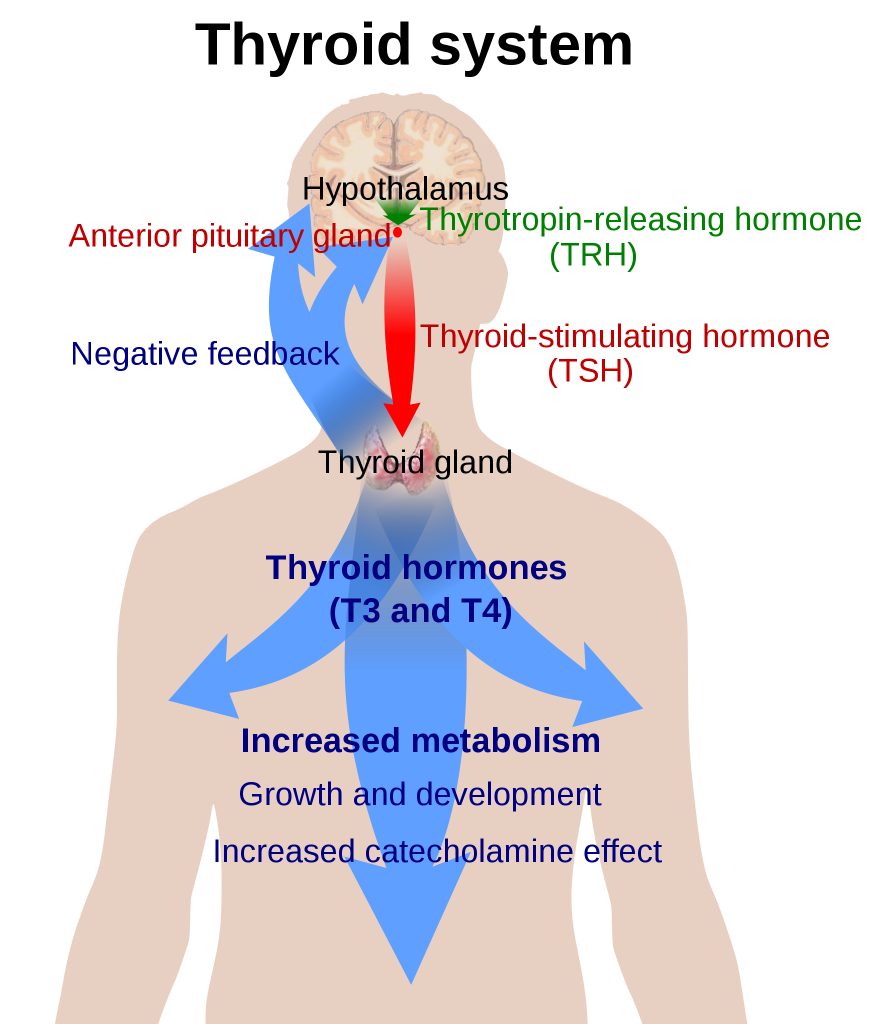
Adrenocorticotropic Hormone (ACTH)
The hypothalamus stimulates the anterior pituitary with corticotropin-releasing hormone (CRH). In response, the anterior pituitary releases adrenocorticotropic hormone (ACTH) to stimulate the adrenal cortex to release corticosteroids.[7]
A negative feedback loop regulates the release of ACTH by the anterior pituitary. For example, if levels of corticosteroids decrease in the bloodstream, the hypothalamus increases the secretion of CRH, causing the anterior pituitary to increase the secretion of ACTH. This is often referred to as the hypothalamus-pituitary-adrenal (HPA) axis. See Figure 7.5[8] for an image of the HPA axis and negative feedback loop.
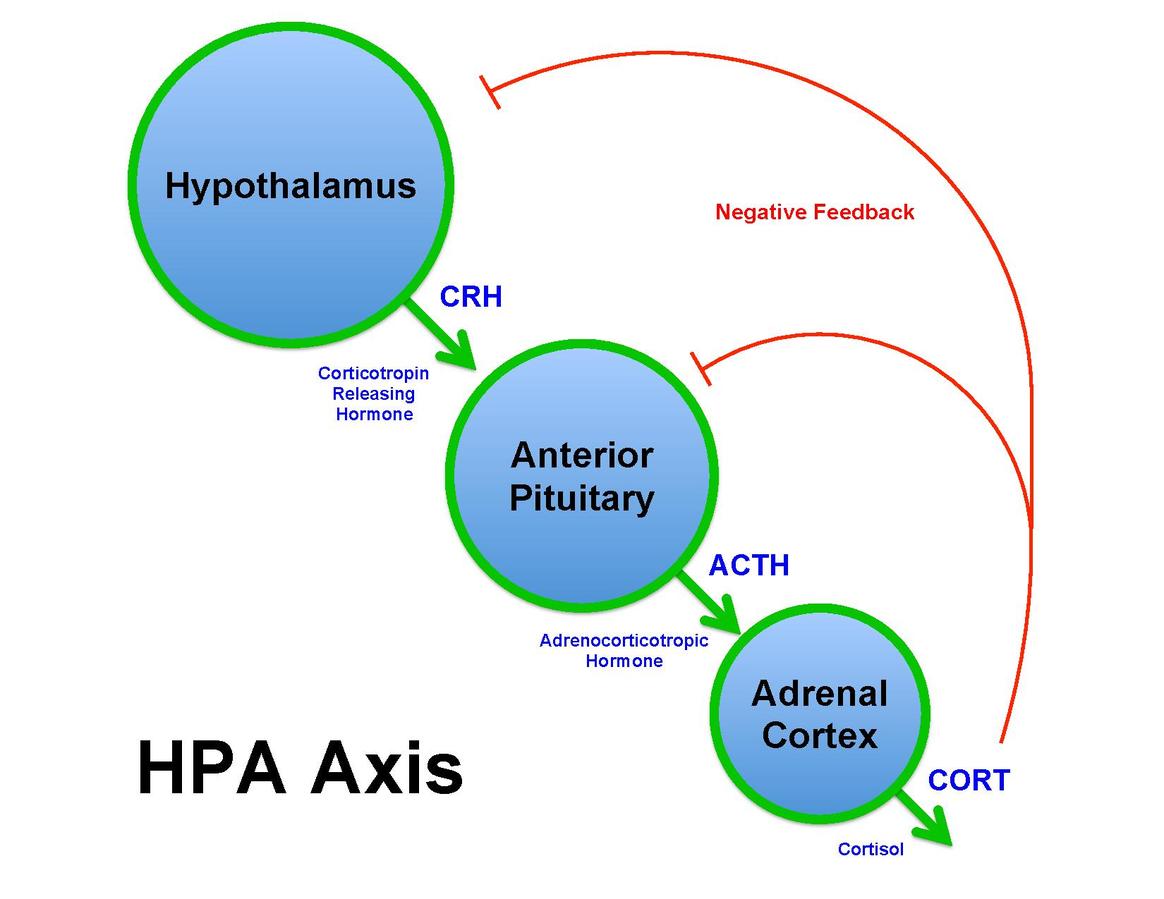
Thyroid Gland
The thyroid gland is a butterfly-shaped endocrine gland located in the neck, just below the larynx. It helps to regulate metabolic processes in the body by producing and releasing thyroid hormones.
The thyroid releases these two hormones:
- Thyroxine (T4)
- Triiodothyronine (T3)
Both T3 and T4 are iodine-containing compounds. These hormones are critical for regulating the body’s basal metabolic rate (BMR), the rate at which the body burns energy at rest.
The primary functions of thyroid hormones T3 and T4 include the following:
- Regulation of Metabolism: Control how the body uses energy and oxygen, impacting processes such as digestion, heart rate, and temperature regulation.
- Growth and Development: Impact normal growth and development, particularly in children and infants. They influence the growth of bones, as well as the development of the brain and the nervous system.
- Temperature Regulation: Regulate body temperature by controlling heat production and heat dissipation mechanisms.
- Energy Production: Involved in the conversion of food into energy. They affect the breakdown of carbohydrates, fats, and proteins for energy use.
- Heart Rate and Blood Pressure: Influence heart rate and the strength of heart contractions, helping to maintain cardiovascular function.
- Brain Function: Play a role in cognitive function, mood regulation, and mental alertness. For example, hypothyroidism (low thyroid hormone levels) can lead to cognitive and emotional changes.
The production and release of thyroid hormones are regulated by the hypothalamus-pituitary complex discussed earlier in this chapter.
Parathyroid Glands
Four small masses of tissue are embedded on the surface of the thyroid gland called parathyroid glands.
Parathyroid glands secrete parathyroid hormone (PTH). PTH maintains homeostasis between calcium and phosphorus via a negative feedback loop. Calcium and phosphorus have an inverse relationship, meaning if phosphorus levels rise, calcium levels will drop.
Adrenal Glands
The adrenal glands are small glands located on top of each kidney. There are two parts to the adrenal gland called the adrenal cortex and the adrenal medulla. Each part has distinct functions:
- Adrenal Cortex: The adrenal cortex is responsible for producing a group of steroid hormones known as corticosteroids. Corticosteroids can be further divided into three categories called mineralocorticoids, glucocorticoids, and androgens.
- Mineralocorticoids: The principal mineralocorticoid is aldosterone. Aldosterone regulates electrolyte and fluid balance in the body by controlling sodium and potassium levels in the blood. It is a key component of the renin-angiotensin-aldosterone system (RAAS) in which specialized cells of the kidneys secrete renin in response to low blood volume or low blood pressure. Renin then catalyzes angiotensinogen to the hormone Angiotensin I. Angiotensin I is converted to Angiotensin II by the angiotensin-converting enzyme (ACE). Angiotensin II stimulates the release of aldosterone. Many cardiac medications target the effects of aldosterone and the RAAS system. For example, ACE inhibitors block the production of Angiotensin II and are used to reduce high blood pressure.
- Glucocorticoids: The principal glucocorticoid is cortisol. Cortisol is the most important glucocorticoid because it plays a crucial role in metabolism, immune response, and the body’s response to stress. Cortisol helps regulate blood sugar levels, suppress inflammation, and manage the stress response.
- Androgens: These are secreted in minimal amounts in both sexes by the adrenal cortex, but their effect is usually masked by the hormones from the testes and ovaries.
- Adrenal Medulla: The adrenal medulla is responsible for producing epinephrine and norepinephrine. These hormones play a central role in the body’s “fight or flight” response to stress that is triggered by the sympathetic nervous system. Epinephrine and norepinephrine prepare the body for action by increasing heart rate, dilating airways, and redirecting blood flow to muscles, among other effects.
View a supplementary YouTube video[9] on ACTH and the adrenal gland:
Ovaries and Testes
In females, the ovaries produce ova (eggs), and in males, the testes produce sperm. Ovaries and testes also secrete hormones.
Ovaries secrete estrogen and progesterone[10]:
- At the onset of puberty, estrogen promotes the development of breasts and the maturation of the uterus.
- Progesterone causes the uterine lining to thicken in preparation for pregnancy.
- Together, progesterone and estrogen are responsible for the changes that occur in the uterus during the female menstrual cycle.
Testes secrete testosterone. At the onset of puberty, testosterone is responsible for the following actions[11]:
- The growth and development of the male reproductive structures
- Increased skeletal and muscular growth
- Enlargement of the larynx accompanied by voice changes
- Growth and distribution of body hair
Pancreas
The pancreas is a long, flat gland that lies behind the stomach. The pancreas serves two roles called exocrine and endocrine. The exocrine role refers to the release of digestive enzymes called amylase and lipase that help to digest food. The endocrine role refers to the production of glucagon and insulin by clusters of cells called islet cells to regulate blood glucose levels and keep them within a healthy range. See Figure 7.6[12] for an illustration of the pancreas.

The islet cells in the pancreas include alpha, beta, and delta cells:
- Alpha Cells: Alpha cells secrete a hormone called glucagon. The primary function of glucagon is to increase blood glucose levels. When blood glucose levels drop (such as between meals or during exercise), glucagon is released.
- Beta Cells: Beta cells secrete insulin. Insulin facilitates the uptake of glucose by cells from the bloodstream, thus reducing blood glucose levels.
- Delta Cells: Delta cells secrete somatostatin. Somatostatin slows down the secretion of insulin and glucagon when needed to maintain blood glucose homeostasis.
Regulation of Blood Glucose Levels by Insulin and Glucagon
Glucose is the primary fuel for all body cells and the only fuel source for the brain. The digestive system breaks down carbohydrates into glucose, where it is absorbed into the bloodstream. Glucose is taken up by cells for fuel. Glucose that is not immediately used by cells is stored in the liver and muscles as glycogen. It is also converted into triglycerides and stored in adipose (fat) tissue.
Blood glucose levels are maintained by healthy individuals’ bodies between 70 mg/dL and 110 mg/dL. Receptors located in the pancreas sense blood glucose levels, and the islet cells secrete glucagon or insulin to maintain normal blood glucose levels. If blood glucose levels rise above this range, insulin is released, which stimulates body cells to take in glucose from the blood. If blood glucose levels drop below this range, glucagon is released, which stimulates cells to release glucose from the stored glycogen into the bloodstream.
Glucagon
When blood glucose levels drop between meals or during exercise, the alpha cells secrete glucagon, which increases blood glucose levels by stimulating the following actions:
- Within cells, it inhibits the uptake of glucose.
- It stimulates the liver to convert stored glycogen into glucose and release it into the bloodstream, a process called glycogenolysis.
- It stimulates the liver to take up amino acids from the blood and converts them into glucose, a process called gluconeogenesis.
- It stimulates the breakdown of stored triglycerides into free fatty acids and glycerol, a process called lipolysis. Glycerol travels to the liver, where it is converted into glucose. This is also a form of gluconeogenesis.
Insulin
The presence of food in the intestine triggers the beta cells in the pancreas to produce and secrete insulin. As blood glucose levels continue to rise as nutrients are absorbed into the bloodstream, insulin continues to be released and stimulates the following actions:
- It stimulates the uptake of glucose by cells by triggering the movement of glucose transporters to the cell membranes, which move glucose into the interior of cells for energy. Glycolysis is the first step in the breakdown of glucose to extract energy for cellular metabolism.
- It stimulates the liver to convert excess blood glucose into glycogen for storage. It also inhibits glycogenolysis and gluconeogenesis.
- Excess glucose is synthesized into triglycerides, a process called lipogenesis.
The secretion of insulin and glucagon by the pancreas is regulated through a negative feedback loop. As glucose levels decrease in the bloodstream, insulin release is inhibited. Conversely, as glucose levels rise in the bloodstream, glucagon release is inhibited. See Figure 7.7[13] for an illustration of the homeostatic regulation of blood glucose levels.
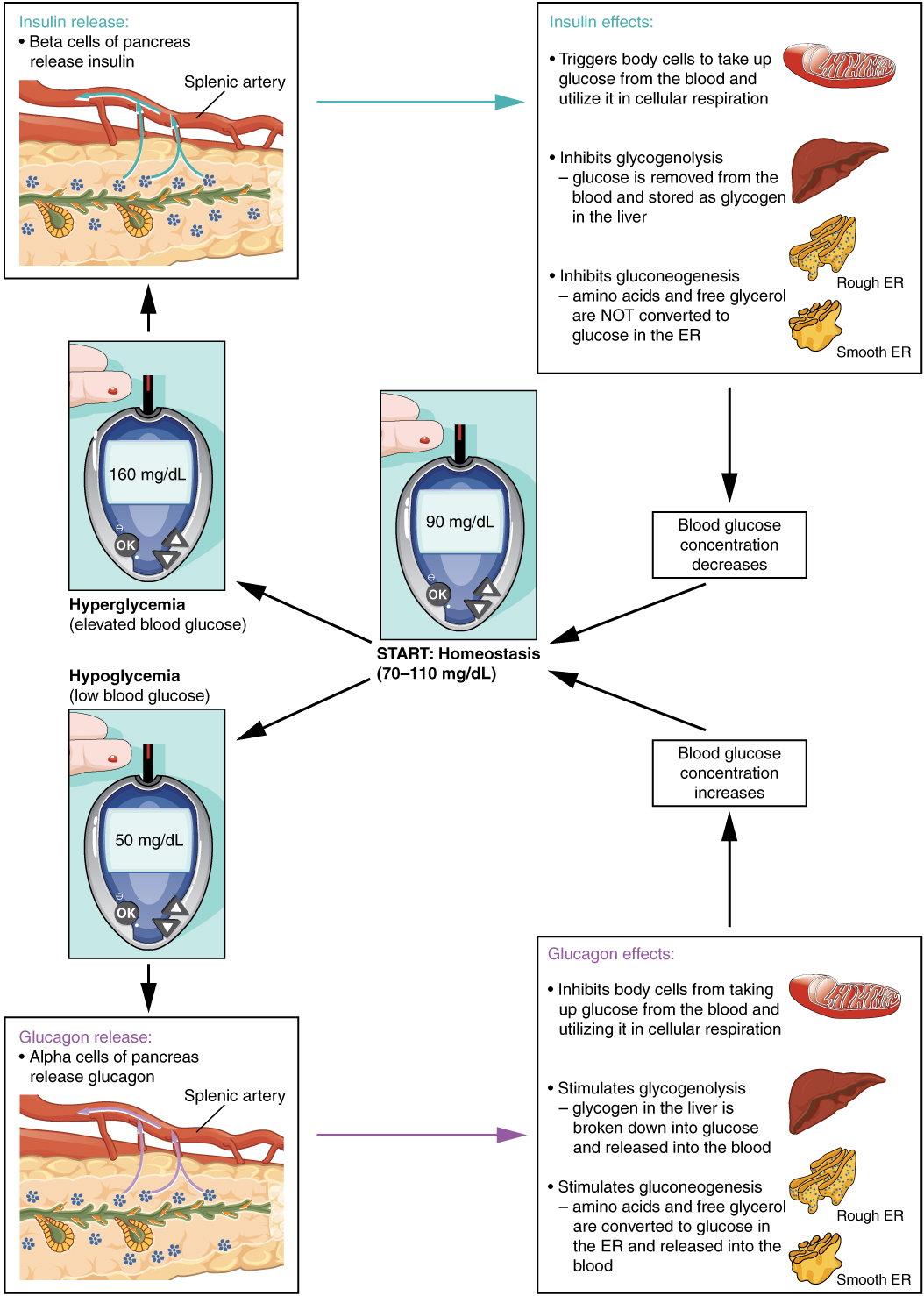
Media Attributions
- 1801_The_Endocrine_System
- 1806_The_Hypothalamus-Pituitary_Complex
- Pituitary Gland by Meredith Pomietlo
- Thyroid_system.svg
- Brian_M_Sweis_HPA_Axis_Diagram_2012.pdf
- 1820_The_Pancreas
- 1822_The_Homostatic_Regulation_of_Blood_Glucose_Levels (1)
- “1801 The Endocrine System.jpg” by OpenStax is licensed under CC BY 3.0 ↵
- National Cancer Institute. (n.d.). Endocrine glands & their function. https://training.seer.cancer.gov/anatomy/endocrine/glands/ ↵
- “1806 The Hypothalamus-Pituitary Complex.jpg” by OpenStax is licensed under CC BY 3.0 ↵
- "Pituitary Gland" by Meredith Pomietlo is licensed under CC BY 4.0 ↵
- This work is a derivative of Anatomy and Physiology by OpenStax licensed under CC BY 4.0. Access for free at https://openstax.org/books/anatomy-and-physiology/pages/1-introduction ↵
- “Thyroid_system.svg” by Mikael Häggström is licensed in the Public Domain. ↵
- This work is a derivative of Anatomy and Physiology by OpenStax licensed under CC BY 4.0. Access for free at https://openstax.org/books/anatomy-and-physiology/pages/1-introduction ↵
- “Brian_M_Sweis_HPA_Axis_Diagram_2012.pdf” by BrianMSweis is licensed under CC BY-SA 3.0 ↵
- Forciea, B. (2015, May 12). Anatomy and physiology: Endocrine system: ACTH (Adrenocorticotropin hormone) V2.0 [Video]. YouTube. All rights reserved. Video reused with permission. https://youtu.be/4m7XflJzm2w. ↵
- National Cancer Institute. (n.d.). Gonads. https://training.seer.cancer.gov/anatomy/endocrine/glands/gonads.html ↵
- National Cancer Institute. (n.d.). Gonads. https://training.seer.cancer.gov/anatomy/endocrine/glands/gonads.html ↵
- “1820 The Pancreas.jpg” by OpenStax is licensed under CC BY 3.0 ↵
- “1822 The Homeostatic Regulation of Blood Glucose Levels.jpg” by OpenStax is licensed under CC BY 3.0 ↵
Before discussing specific procedures related to facilitating bowel and bladder function, let’s review basic concepts related to urinary and bowel elimination. When facilitating alternative methods of elimination, it is important to understand the anatomy and physiology of the gastrointestinal and urinary systems, as well as the adverse effects of various conditions and medications on elimination. Use the information below to review information about these topics.
For more information about the anatomy and physiology of the gastrointestinal system and medications used to treat diarrhea and constipation, visit the "Gastrointestinal" chapter of the Open RN Nursing Pharmacology textbook.
For more information about the anatomy and physiology of the kidneys and diuretic medications used to treat fluid overload, visit the "Cardiovascular and Renal System" chapter in Open RN Nursing Pharmacology textbook.
For more information about applying the nursing process to facilitate elimination, visit the "Elimination" chapter in Open RN Nursing Fundamentals.
Urinary Elimination Devices
This section will focus on the devices used to facilitate urinary elimination. Urinary catheterization is the insertion of a catheter tube into the urethral opening and placing it in the neck of the urinary bladder to drain urine. There are several types of urinary elimination devices, such as indwelling catheters, intermittent catheters, suprapubic catheters, and external devices. Each of these types of devices is described in the following subsections.
Indwelling Catheter
An indwelling catheter, often referred to as a “Foley catheter,” refers to a urinary catheter that remains in place after insertion into the bladder for the continual collection of urine. It has a balloon on the insertion tip to maintain placement in the neck of the bladder. The other end of the catheter is attached to a drainage bag for the collection of urine. See Figure 21.1[1] for an illustration of the anatomical placement of an indwelling catheter in the bladder neck.
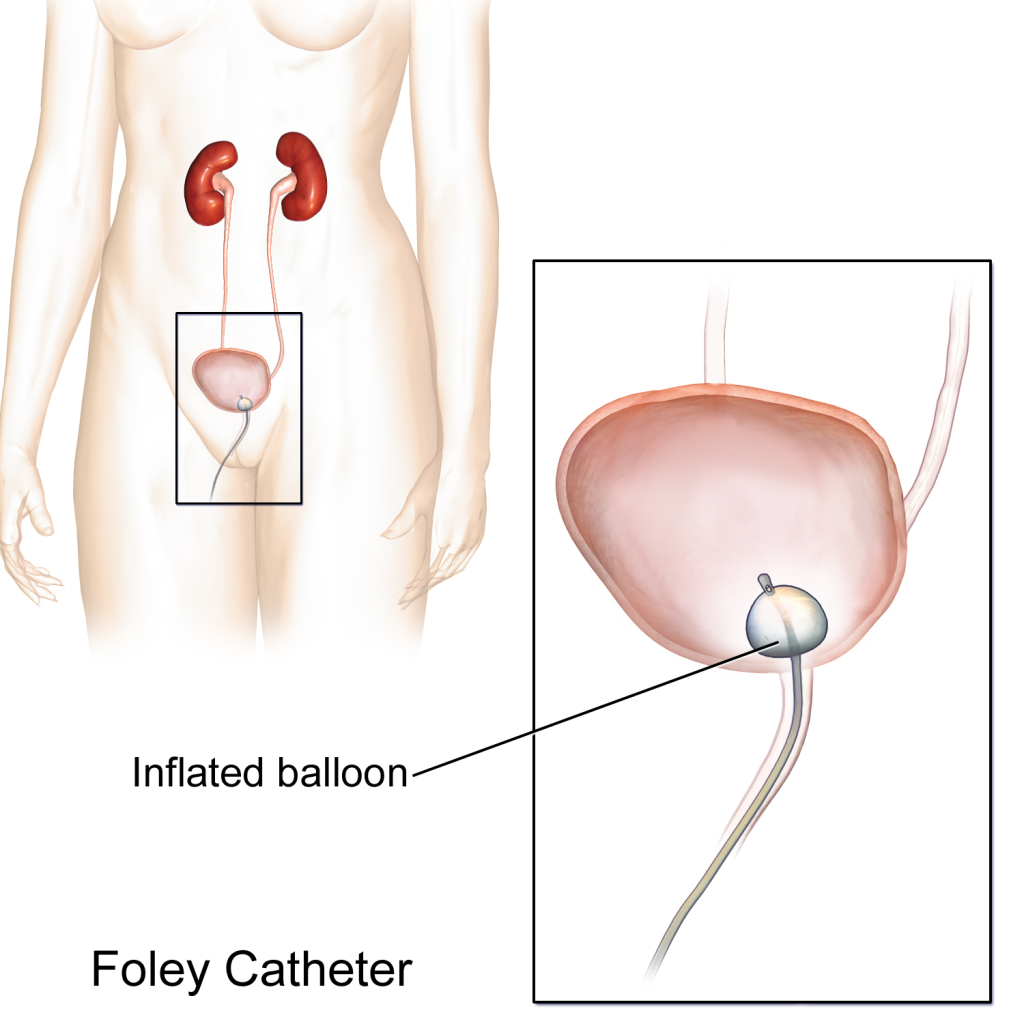
The distal end of an indwelling catheter has a urine drainage port that is connected to a drainage bag. The size of the catheter is marked at this end using the French catheter scale. A balloon port is also located at this end, where a syringe is inserted to inflate the balloon after it is inserted into the bladder. The balloon port is marked with the amount of fluid required to fill the balloon. See Figure 21.2[2] for an image of the parts of an indwelling catheter.
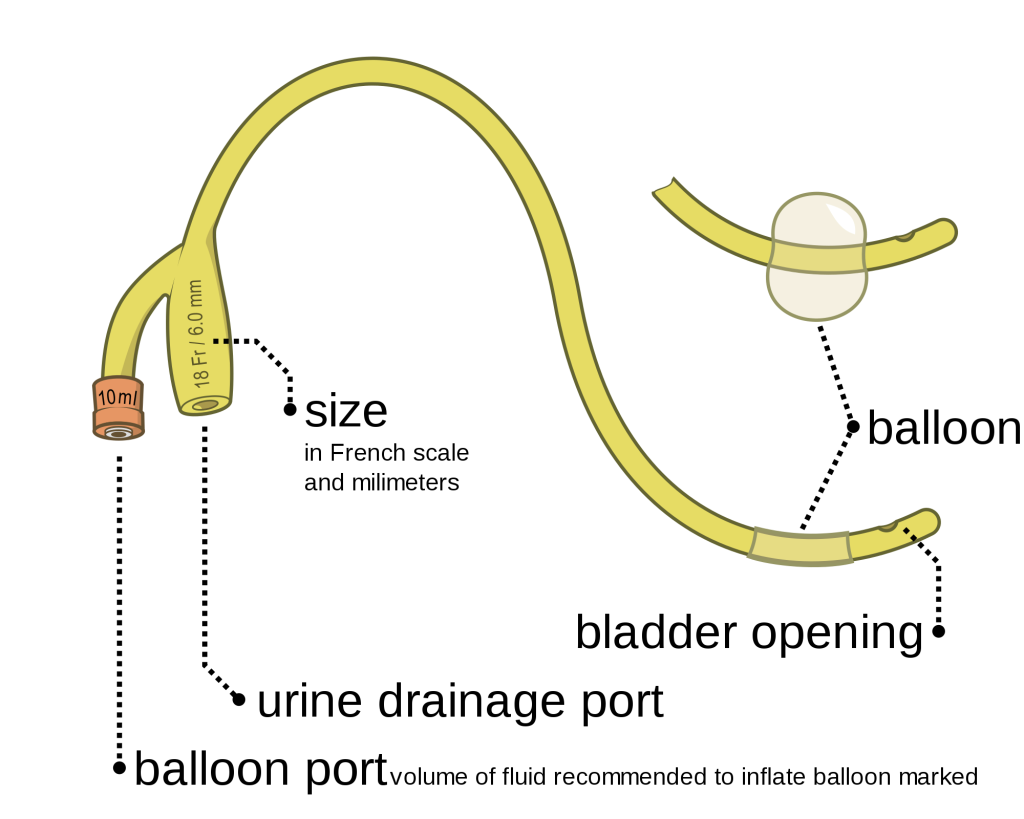
Catheters have different sizes, with the larger the number indicating a larger diameter of the catheter. See Figure 21.3[3] for an image of the French catheter scale.
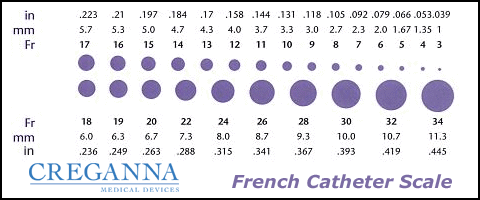
There are two common types of bags that may be attached to an indwelling catheter. During inpatient or long-term care, larger collection bags that can hold up to two liters of fluid are used. See Figure 21.4[4] for an image of a typical collection bag attached to an indwelling catheter. These bags should be emptied when they are half to two-thirds full to prevent traction on the urethra from the bag. Additionally, the collection bag should always be placed below the level of the patient’s bladder so that urine flows out of the bladder and urine does not inadvertently flow back into the bladder. Ensure the tubing is not coiled, kinked, or compressed so that urine can flow unobstructed into the bag. Slack should be maintained in the tubing to prevent injury to the patient's urethra. To prevent the development of a urinary tract infection, the bag should not be permitted to touch the floor.
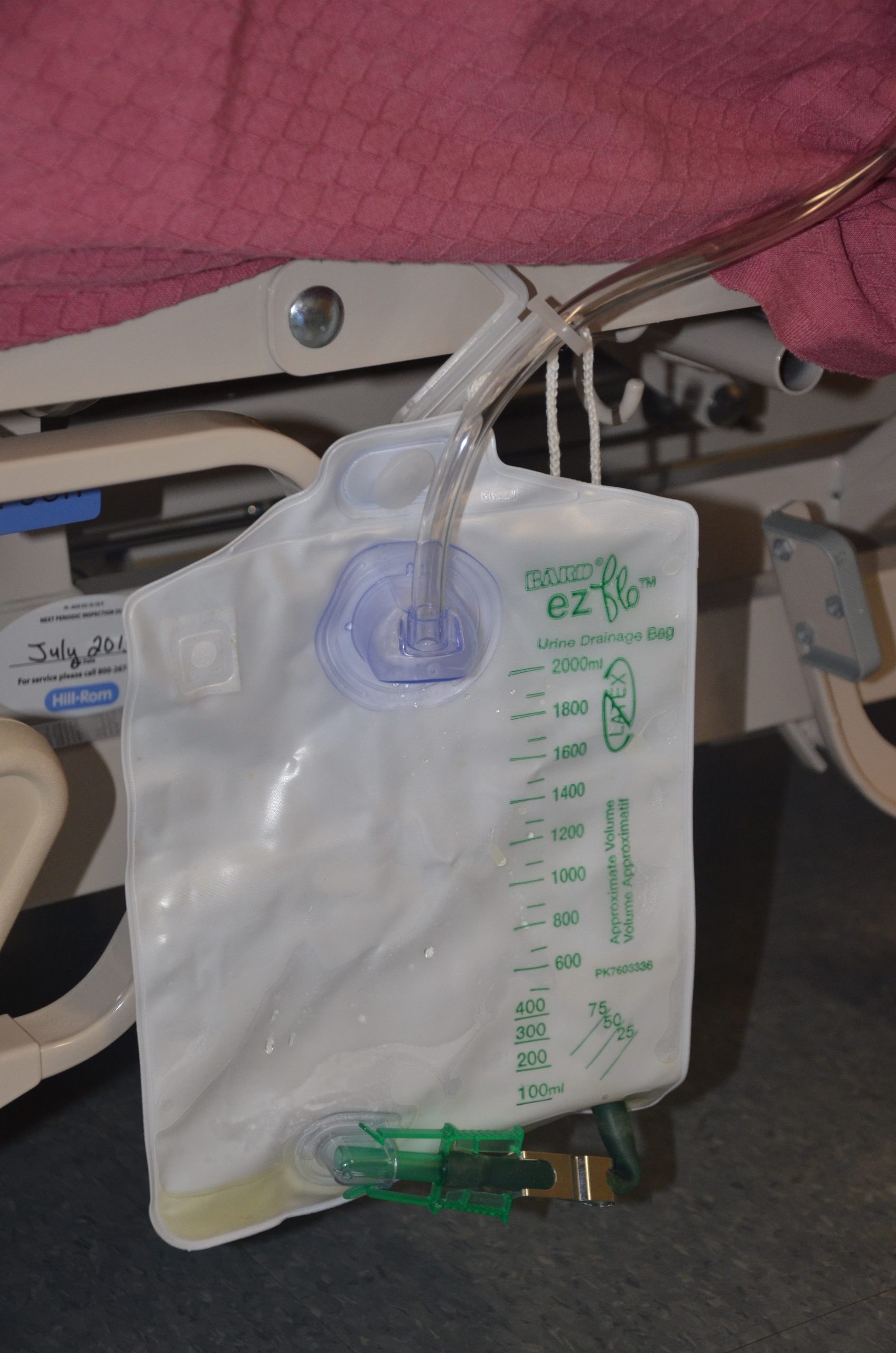
See Figure 21.5[5] for an illustration of the placement of the urine collection bag when the patient is lying in bed.
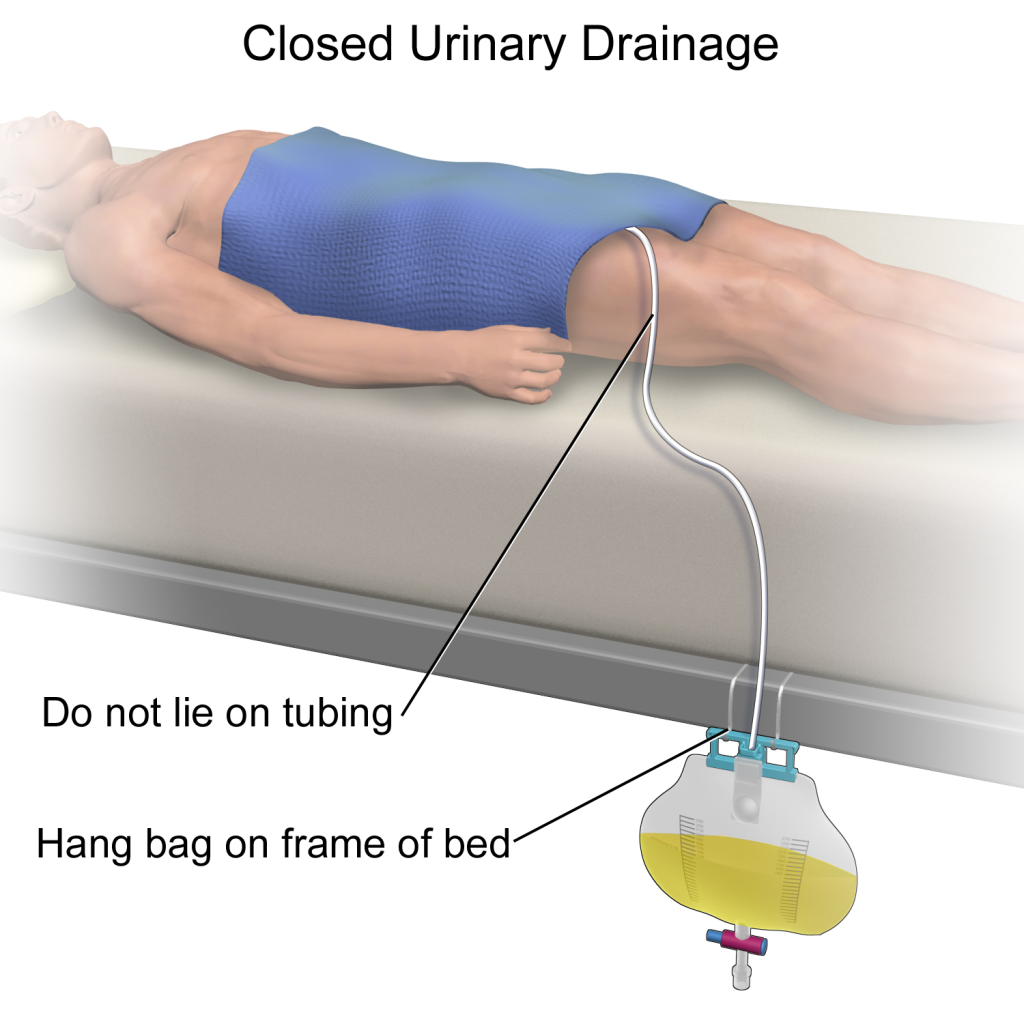
A second type of urine collection bag is a leg bag. Leg bags provide discretion when the patient is in public because they can be worn under clothing. However, leg bags are small and must be emptied more frequently than those used during inpatient care. Figure 21.6[6] for an image of leg bag and Figure 21.7[7] for an illustration of an indwelling catheter attached to a leg bag.
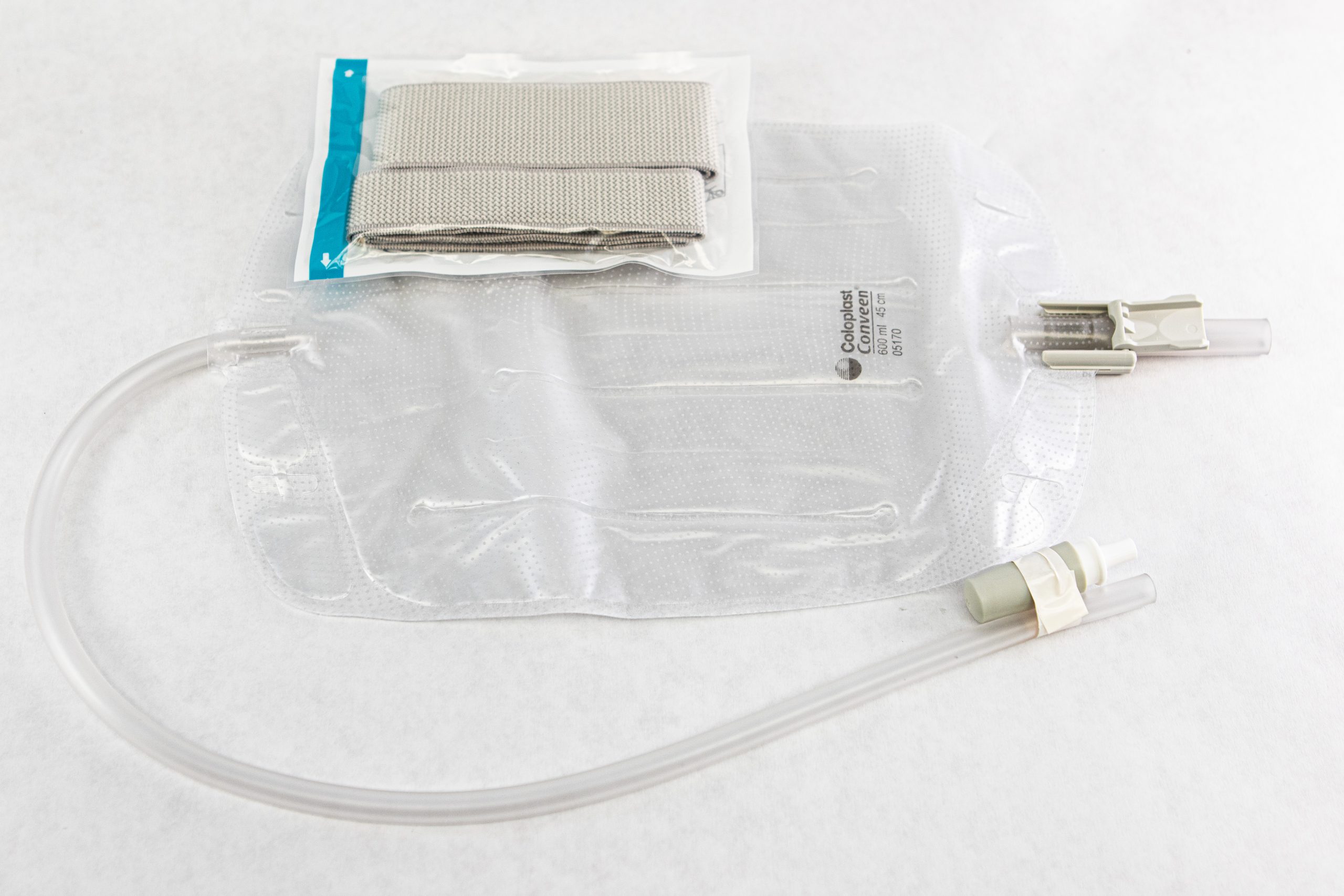
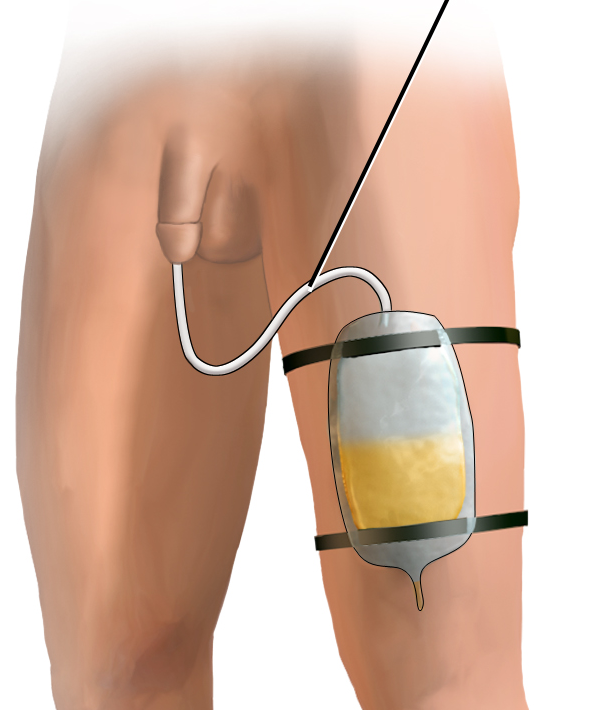
Straight Catheter
A straight catheter is used for intermittent urinary catheterization. The catheter is inserted to allow for the flow of urine and then immediately removed, so a balloon is not required at the insertion tip. See Figure 21.8[8] for an image of a straight catheter. Intermittent catheterization is used for the relief of urinary retention. It may be performed once, such as after surgery when a patient is experiencing urinary retention due to the effects of anesthesia, or performed several times a day to manage chronic urinary retention. Some patients may also independently perform self-catheterization at home to manage chronic urinary retention caused by various medical conditions. In some situations, a straight catheter is also used to obtain a sterile urine specimen for culture when a patient is unable to void into a sterile specimen cup. According to the Centers for Disease Control and Prevention (CDC), intermittent catheterization is preferred to indwelling urethral catheters whenever feasible because of decreased risk of developing a urinary tract infection.[9]
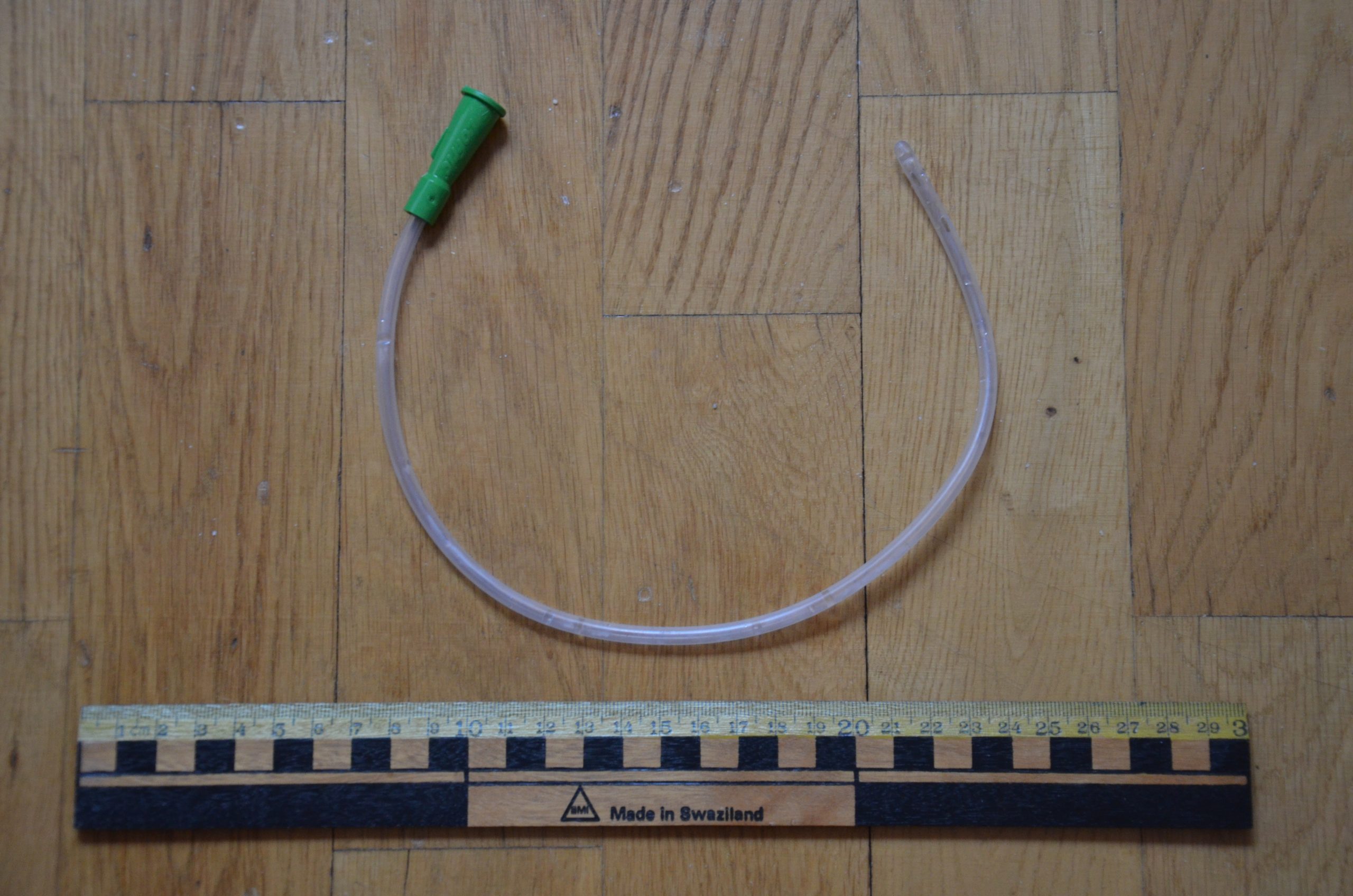
Other Types of Urinary Catheters
Coude Catheter Tip
Coude catheter tips are curved to follow the natural curve of the urethra during catheterization. They are often used when catheterizing male patients with enlarged prostate glands. See Figure 21.9[10] for an example of a urinary catheter with a coude tip. During insertion, the tip of the coude catheter must be pointed anteriorly or it can cause damage to the urethra. A thin line embedded in the catheter provides information regarding orientation during the procedure; maintain the line upwards to keep it pointed anteriorly.
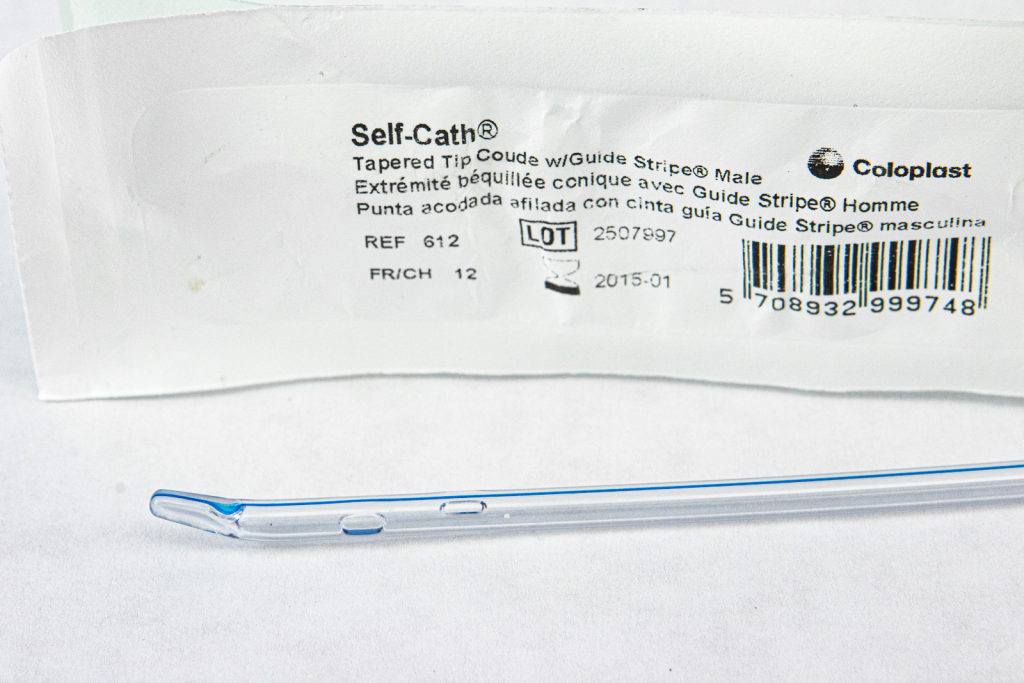
Irrigation Catheter
Irrigation catheters are typically used after prostate surgery to flush the surgical area. These catheters are larger in size to allow for irrigation of the bladder to help prevent the formation of blood clots and to flush them out. See Figure 21.10[11] for an image comparing a larger 20 French catheter (typically used for irrigation) to a 14 French catheter (typically used for indwelling catheters).

Suprapubic Catheters
Suprapubic catheters are surgically inserted through the abdominal wall into the bladder. This type of catheter is typically inserted when there is a blockage within the urethra that does not allow the use of a straight or indwelling catheter. Suprapubic catheters may be used for a short period of time for acute medical conditions or may be used permanently for chronic conditions. See Figure 21.11[12] for an image of a suprapubic catheter. The insertion site of a suprapubic catheter must be cleaned regularly according to agency policy with appropriate steps to prevent skin breakdown.
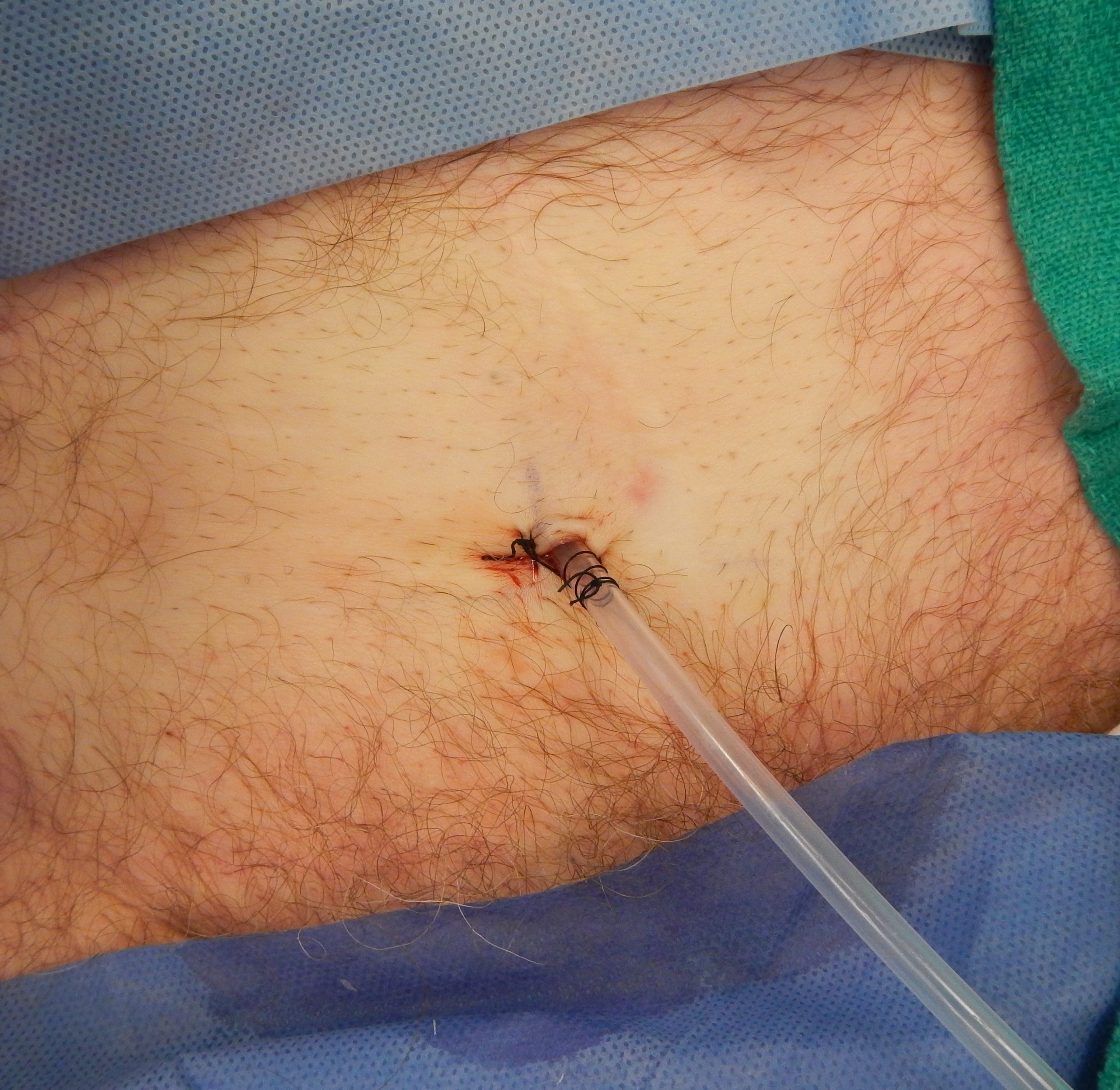
Male Condom Catheter
A condom catheter is a noninvasive device used for males with incontinence. It is placed over the penis and connected to a drainage bag. This device protects and promotes healing of the skin around the perineal area and inner legs and is used as an alternative to an indwelling urinary catheter. See Figure 21.12[13] for an image of a condom catheter and Figure 21.13[14] for an illustration of a condom catheter attached to a leg bag.
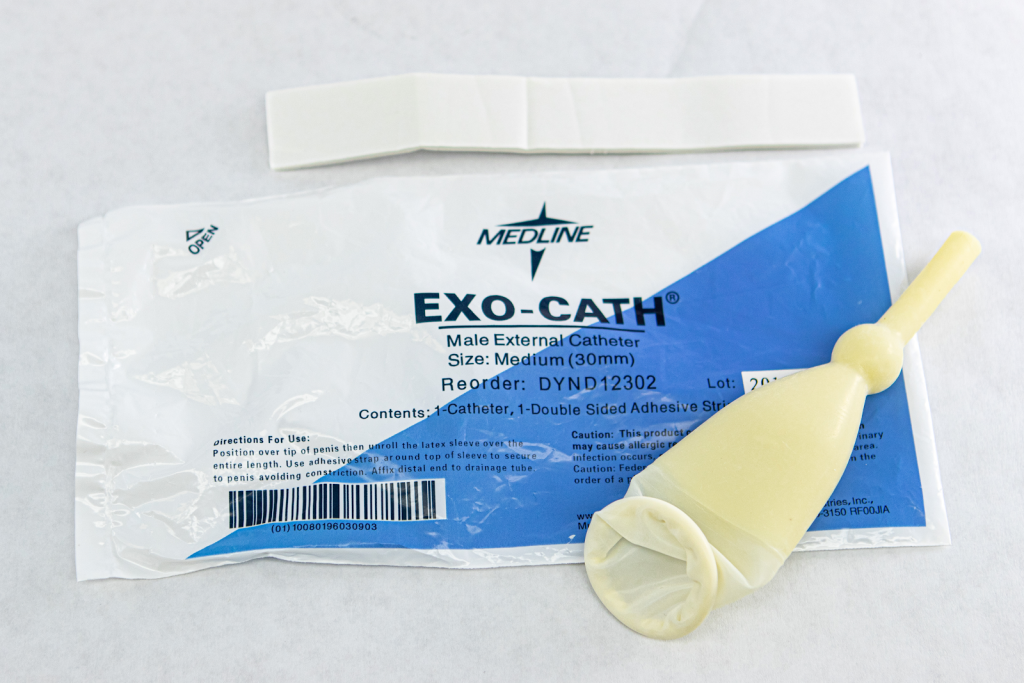
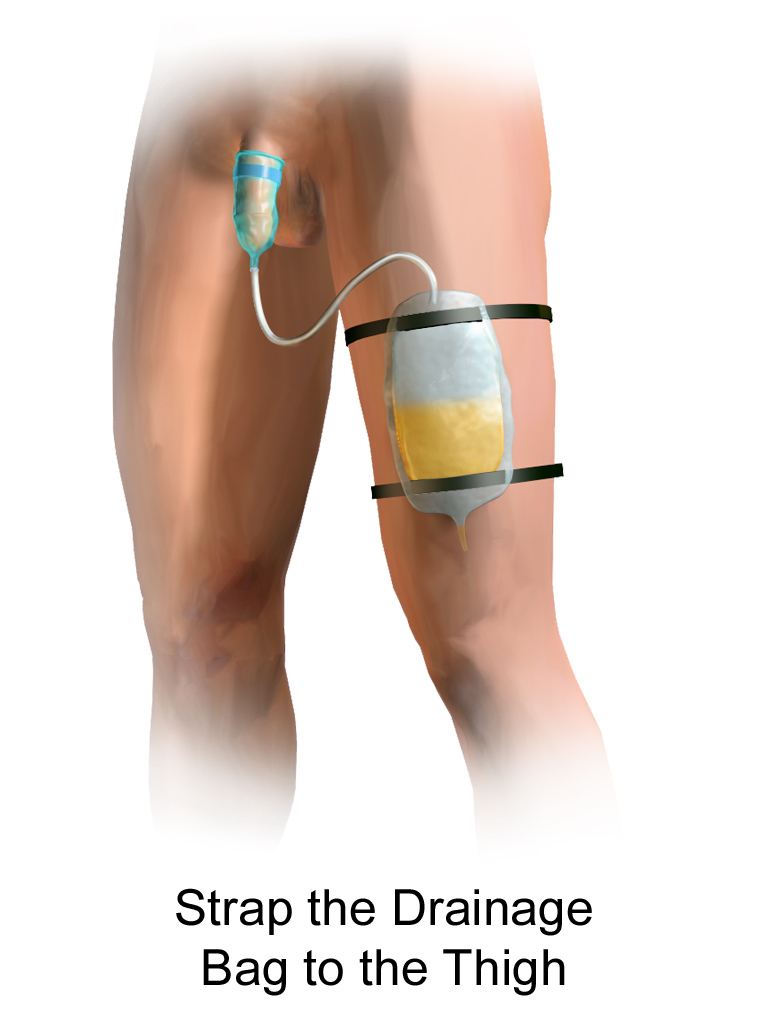
Female External Urinary Catheter
Female external urinary catheters (FEUC) have been recently introduced into practice to reduce the incidence of catheter-associated urinary tract infection (CAUTI) in women.[15] The external female catheter device is made of a purewick material that is placed externally over the female’s urinary meatus. The wicking material is attached to a tube that is hooked to a low-suction device. When the wick becomes saturated with urine, it is suctioned into a drainage canister. Preliminary studies have found that utilizing the FEUC device reduced the risk for CAUTI.[16],[17]
View these supplementary YouTube videos on female external urinary catheters:
Students demonstrate use of PureWick female external catheter[18]
How to use the use the PureWick - a female external catheter[19]
A catheter-associated urinary tract infection (CAUTI) is a common, life-threatening complication caused by indwelling urinary catheters. The development of a CAUTI is associated with patients’ increased length of stay in the hospital, resulting in additional hospital costs and a higher risk of death. It is estimated that 17% to 69% of CAUTI cases are preventable, meaning that up to 380,000 infections and 9,000 patient deaths per year related to CAUTI can be prevented with appropriate nursing measures.[20]
Nurses can save lives, prevent harm, and lower health care costs by following interventions outlined in the document created by the American Nurses Association titled Streamlined Evidence-Based RN Tool: Catheter Associated Urinary Tract Infection (CAUTI) Prevention. Review the entire tool in the box provided below. Key interventions include the following:
- Ensure the patient meets CDC-approved indications prior to inserting an indwelling catheter. If the patient does not meet the approved indications, contact the provider and advocate for an alternative method to facilitate elimination.
- According to the Centers for Disease Control and Prevention (CDC), appropriate indications for inserting an indwelling urinary catheter include the following[21]:
- Urinary retention or bladder outlet obstruction
- Hourly monitoring of urinary output in critically ill patients
- Perioperative use for selected surgeries
- Healing of open sacral and perineal wounds in patients with urinary incontinence
- Prolonged immobilization
- End-of-life care[22]
- Inappropriate reasons for inserting an indwelling urinary catheter include the following:
- Substitution of nursing care for a patient or resident with incontinence
- A means for obtaining a urine culture when a patient can voluntarily void
- Prolonged postoperative care without appropriate indications[23]
- According to the Centers for Disease Control and Prevention (CDC), appropriate indications for inserting an indwelling urinary catheter include the following[21]:
- After an indwelling urinary catheter is inserted, assess the patient daily to determine if the patient still meets the CDC criteria for an indwelling catheter and document the findings. If the patient no longer meets the approved criteria, follow agency policy for removal.
- When an indwelling catheter is in place, prevent CAUTI by following the maintenance steps outlined by the CDC.
- Continually monitor for signs of a CAUTI and report concerns to the health care provider.[24]
- Signs and symptoms of CAUTI to urgently report to the health care provider include fever greater than 38 degrees Celsius, change in mental status such as confusion or lethargy, chills, malodorous urine, and suprapubic or flank pain. Flank pain can be assessed by assisting the patient to a sitting or side-lying position and percussing the costovertebral areas.[25]
Read a nurse-driven, evidence-based PDF tool to prevent CAUTI from the American Nurses Association[26]: Streamlined Evidence-Based RN Tool: Catheter Associated Urinary Tract Infection (CAUTI) Prevention
Safely and accurately placing an indwelling urinary catheter poses several challenges that require the nurse to use clinical judgment. Challenges can include anatomical variations in a specific patient, medical conditions affecting patient positioning, and maintaining sterility of the procedure with confused or agitated patients. See the checklists on Foley Catheter Insertion (Male) and Foley Catheter Insertion (Female) for detailed instructions.
Nursing interventions to prevent the development of a catheter-associated urinary tract infection (CAUTI) on insertion include the following[27]:
- Determine if insertion of an indwelling catheter meets CDC guidelines.
- Select the smallest-sized catheter that is appropriate for the patient, typically a 14 French.
- Obtain assistance as needed to facilitate patient positioning, visualization, and insertion. Many agencies require two nurses for the insertion of indwelling catheters.
- Perform perineal care before inserting a urinary catheter and regularly thereafter.
- Perform hand hygiene before and after insertion, as well as during any manipulation of the device or site.
- Maintain strict aseptic technique during insertion and use sterile gloves and equipment.
- Inflate the balloon after insertion per manufacturer instructions. It is not recommended to preinflate the balloon prior to insertion.
- Properly secure the catheter after insertion to prevent tissue damage.
- Keep the drainage bag below the bladder but not resting on the floor.
- Check the system to ensure there are no kinks or obstructions to urine flow.
- Provide routine hygiene of the urinary meatus during daily bathing and cleanse the perineal area after every bowel movement. In uncircumcised males, gently retract the foreskin, cleanse the meatus, and then return the foreskin to the original position. Do not cleanse the periurethral area with antiseptics after the catheter is in place.[28] To avoid contaminating the urinary tract, always clean by wiping away from the urinary meatus.
- Empty the collection bag regularly using a separate, clean collecting container for each patient. Avoid splashing and prevent contact of the drainage spigot with the nonsterile collecting container or other surfaces. Never allow the bag to touch the floor.[29],[30]
Video Review of Thompson Rivers University's Urinary Catheterization:
Safely and accurately placing an indwelling urinary catheter poses several challenges that require the nurse to use clinical judgment. Challenges can include anatomical variations in a specific patient, medical conditions affecting patient positioning, and maintaining sterility of the procedure with confused or agitated patients. See the checklists on Foley Catheter Insertion (Male) and Foley Catheter Insertion (Female) for detailed instructions.
Nursing interventions to prevent the development of a catheter-associated urinary tract infection (CAUTI) on insertion include the following[33]:
- Determine if insertion of an indwelling catheter meets CDC guidelines.
- Select the smallest-sized catheter that is appropriate for the patient, typically a 14 French.
- Obtain assistance as needed to facilitate patient positioning, visualization, and insertion. Many agencies require two nurses for the insertion of indwelling catheters.
- Perform perineal care before inserting a urinary catheter and regularly thereafter.
- Perform hand hygiene before and after insertion, as well as during any manipulation of the device or site.
- Maintain strict aseptic technique during insertion and use sterile gloves and equipment.
- Inflate the balloon after insertion per manufacturer instructions. It is not recommended to preinflate the balloon prior to insertion.
- Properly secure the catheter after insertion to prevent tissue damage.
- Keep the drainage bag below the bladder but not resting on the floor.
- Check the system to ensure there are no kinks or obstructions to urine flow.
- Provide routine hygiene of the urinary meatus during daily bathing and cleanse the perineal area after every bowel movement. In uncircumcised males, gently retract the foreskin, cleanse the meatus, and then return the foreskin to the original position. Do not cleanse the periurethral area with antiseptics after the catheter is in place.[34] To avoid contaminating the urinary tract, always clean by wiping away from the urinary meatus.
- Empty the collection bag regularly using a separate, clean collecting container for each patient. Avoid splashing and prevent contact of the drainage spigot with the nonsterile collecting container or other surfaces. Never allow the bag to touch the floor.[35],[36]
Video Review of Thompson Rivers University's Urinary Catheterization:
When preparing to insert an indwelling urinary catheter, it is important to use the nursing process to plan and provide care to the patient. Begin by assessing the appropriateness of inserting an indwelling catheter according to CDC criteria as discussed in the “Preventing CAUTI” section of this chapter. Determine if alternative measures can be used to facilitate elimination and address any concerns with the prescribing provider before proceeding with the provider order.
Subjective Assessment
In addition to verifying the appropriateness of the insertion of an indwelling catheter according to CDC recommendations, it is also important to assess for any conditions that may interfere with the insertion of a urinary catheter when feasible. See suggested interview questions prior to inserting an indwelling catheter and their rationale in Table 21.8a.
Table 21.8a Suggested Interview Questions Prior to Urinary Catheterization
| Interview Questions | Rationale |
|---|---|
| Do you have any history of urinary problems such as frequent urinary tract infections, urinary tract surgeries, or bladder cancer?
For males: Do you have any history of prostate enlargement or prostate problems? For females: Have you had any gynecological surgeries? |
Previous medical conditions and surgeries may interfere with urinary catheter placement. Information about a male patient’s prostate will assist in determining the size and type of catheter used. (Recall that using a catheter with a coude tip is helpful when a male patient has an enlarged prostate.) If a patient has a history of previous urinary tract infections, they may be at higher risk of developing CAUTI. |
| Have you ever had a urinary catheter placed in the past? If so, were there any problems with placement or did you experience any problems while the catheter was in place? | Questioning the patient about placement and prior catheterizations assists the nurse in identifying any problems with catheterization or if the patient has had the procedure before, they may know what to expect. |
| Do you have any questions about this procedure? How do you feel about undergoing catheterization? | The nurse should encourage patient involvement with their care and identify any fears or anxiety. Nurses can decrease or eliminate these fears and anxieties with additional information or reassurance. |
| Do you take any medications that increase urination such as diuretics or any medications that decrease urgency or frequency? If so, please describe. | Identifying medications that increase or decrease urine output is important to consider when monitoring urine output after the catheter is in place. |
| Have you had any orthopedic surgeries that may affect your ability to bend your knees or hips? Are you able to tolerate lying flat for a short period of time? | The patient may not be able to tolerate the positioning required for catheter insertion. If so, additional assistance from other staff may be required for patient comfort and safety. |
Cultural Considerations
When inserting urinary catheters, be aware of and respect cultural beliefs related to privacy, family involvement, and the request for a same-gender nurse. Inserting a urinary catheter requires visualization and manipulation of anatomical areas that are considered private by most patients. These procedures can cause emotional distress, especially if the patient has experienced any history of abuse or trauma.
Objective Assessment
In addition to performing a subjective assessment, there are several objective assessments to complete prior to insertion. See Table 21.8b for a list of objective assessments and their rationale.
Table 21.8b Objective Assessment
| Objective Data Collection | Rationale |
|---|---|
| Review the patient’s medical record for any documented medical conditions the patient may not have reported, such as urethral strictures, structural problems with the bladder or urethra, or frequent urinary tract infections. | Any type of obstruction or scar tissue within these areas may prevent the catheter from advancing into the bladder. |
| Analyze the patient's weight and most recent electrolyte values. | Weight is used to determine a patient's fluid status, especially if they have fluid overload. Electrolyte levels are also affected by fluid balance and the use of diuretic medications. Establish a baseline to use to evaluate outcomes after placing the urinary catheter. |
| Determine the patient's level of consciousness, ability to cooperate, developmental level, and age. | Evaluate the patient’s ability to follow directions and cooperate during the procedure and seek additional assistance during the procedure if needed. This data will impact how to explain the procedure to the patient. |
| Perform physical assessment of the bladder and perineum. Palpate the bladder for signs of fullness and discomfort. (Bladder emptying may also be assessed using a bladder scanner per agency policy). Inspect the perineum for erythema, discharge, drainage, skin ulcerations, or odor. Note the position of anatomical landmarks. For example, in females identify the urethra versus the vaginal opening. | A full bladder produces discomfort and urgency to void, especially on palpation. These symptoms should be relieved with the placement of a urinary catheter.
Identify any abnormal physical signs in the perineal area that may interfere with comfort during insertion. Determining the urethral opening improves accuracy and ease of insertion. |
| When examining the perineal area, note the approximate diameter of the urinary meatus. Choose the smallest, appropriately sized diameter catheter. | An appropriately sized catheter is important to avoid unnecessary discomfort or trauma to the urinary tissue. Catheters that are 14 French diameter are typically used in adults. |
Life Span Considerations
Children
It is often helpful to explain the catheterization procedure using a doll or toy. According to agency policy, a parent, caregiver, or other adult should be present in the room during the procedure. Asking a younger child to blow into a straw can help relax the pelvic muscles during catheterization.
Older Adults
The urethral meatus of older women may be difficult to identify due to atrophy of the urogenital tissue. The risk of developing a urinary tract infection may also be increased due to chronic disease and incontinence.
Expected Outcomes/Planning
Expected patient outcomes following urinary catheterization should be planned and then evaluated and documented after the procedure is completed. See Table 21.8c for sample expected outcomes related to urinary catheterization.
Table 21.8c Expected Outcomes of Urinary Catheterization
| Expected Outcomes | Rationale |
|---|---|
| The patient’s bladder is nondistended and not palpable. | Verifies appropriate bladder emptying. |
| The patient reports no abdominal or bladder discomfort or pressure. | Verifies correct catheter placement by allowing urine flow and relieving discomfort or pressure. |
| Urine output is at least 30 mL/hr. | Verifies correct catheter placement and appropriate kidney functioning. If urine output is less than 30 mL/hour, check tubing for kinking and obstruction, and notify the provider if there is no improvement after manipulating the tubing. |
| Patient verbalizes understanding of the purpose of the catheter and signs of a urinary tract infection to report. | Verifies the patient's understanding of the procedure and signs of complications. |
Implementation
When inserting an indwelling urinary catheter, the expected finding is that the catheter is inserted accurately and without discomfort, and immediate flow of clear, yellow urine into the collection bag occurs. However, unexpected events and findings can occur. See Table 21.8d for examples of unexpected findings and suggested follow-up actions.
Table 21.8d Unexpected Findings and Follow-Up Actions
| Unexpected Findings | Follow-Up Action |
|---|---|
| Urine flow does not occur when catheterizing a female patient. | The catheter may have entered the vagina and not the urethral meatus. Leave the catheter in the vagina as a landmark to avoid incorrect reinsertion. Obtain a new catheter kit and cleanse the urinary meatus again before reinsertion. If reinsertion is successful into the bladder, remove the catheter that is in vagina after the second attempt. |
| Sterile field is broken during the procedure. | If supplies or the catheter become contaminated, obtain a new catheter kit and restart the procedure. |
| Patient reports continued bladder pain or discomfort although urinary flow indicates correct catheter placement. | Ensure there is no tension pulling at the catheter. It may be helpful to deflate the balloon and advance the catheter another 2-3 inches to ensure it is in the bladder and not the urethra. If these actions do not resolve the discomfort, notify the provider because it is possible the patient is experiencing bladder spasms. Continue to monitor urine output for clarity, color, and amount and for signs of urinary tract infection. |
| The nurse is unable to advance the catheter on a male patient with an enlarged prostate. | Do not force advancement because this may cause further damage. Ask the patient to take deep breaths and try again. If a second attempt is unsuccessful, obtain a coude catheter and attempt to reinsert. If unsuccessful with a coude catheter, notify the provider. |
| Urine is cloudy, concentrated, malodorous, dark amber in color, or contains sediment, blood, or pus. | Notify the health care provider of signs and symptoms of a possible urinary tract infection. Obtain a urine specimen as prescribed. |
Evaluation
Evaluate the success of the expected outcomes established prior to the procedure.
Sample Documentation for Expected Findings
A size 14F Foley catheter inserted per provider prescription. Indication: Prolonged urinary retention. Procedure and purpose of Foley catheter explained to patient. Patient denies allergies to iodine, orthopedic limitations, or previous genitourinary surgeries. Balloon inflated with 10 mL of sterile water. Patient verbalized no discomfort or pain with balloon inflation or during the procedure. Peri-care provided before and after procedure. Catheter tubing secured to right upper thigh with stat lock. Drainage bag attached, tubing coiled loosely with no kinks, bag is below bladder level on bed frame. Urine drained with procedure 375 mL. Urine is clear, amber in color, no sediment. Patient resting comfortably; instructed the patient to notify the nurse if develops any bladder pain, discomfort, or spasms. Patient verbalized understanding.
Sample Documentation for Unexpected Findings
A size 14F Foley catheter inserted per provider prescription. Indication is for oliguria with accurate output measurements required. Procedure and purpose of Foley catheter explained to patient. Patient denies allergies to iodine, orthopedic limitations, or previous genitourinary surgeries. As the balloon was being inflated with sterile water, patient began to report discomfort. Water removed, catheter advanced one inch and balloon reinflated with 10 mL of sterile water. Patient denied discomfort after the catheter advancement. Catheter tubing secured to right upper thigh with stat lock. Drainage bag attached, tubing coiled loosely with no kinks, bag is below bladder level. Urine drained with procedure 100 mL. Urine is dark amber, noticeable sediment in tubing, with foul odor. Patient resting comfortably, denies any bladder pain or discomfort. Instructed the patient to notify the nurse if develops any bladder pain, discomfort, or urinary spasms. Patient verbalized understanding. Notify the health care provider of urine assessment. Continue monitoring patient for any new or worsening symptoms such as change in mental status, fever, chills, or hematuria.
Respiratory System Anatomy
It is important for the nurse to have an understanding of the underlying structures of the respiratory system before performing suctioning to ensure that care is given to protect sensitive tissues and that airways are appropriately assessed during the suctioning procedure. See Figure 22.1[39] for an illustration of the anatomy of the respiratory system.
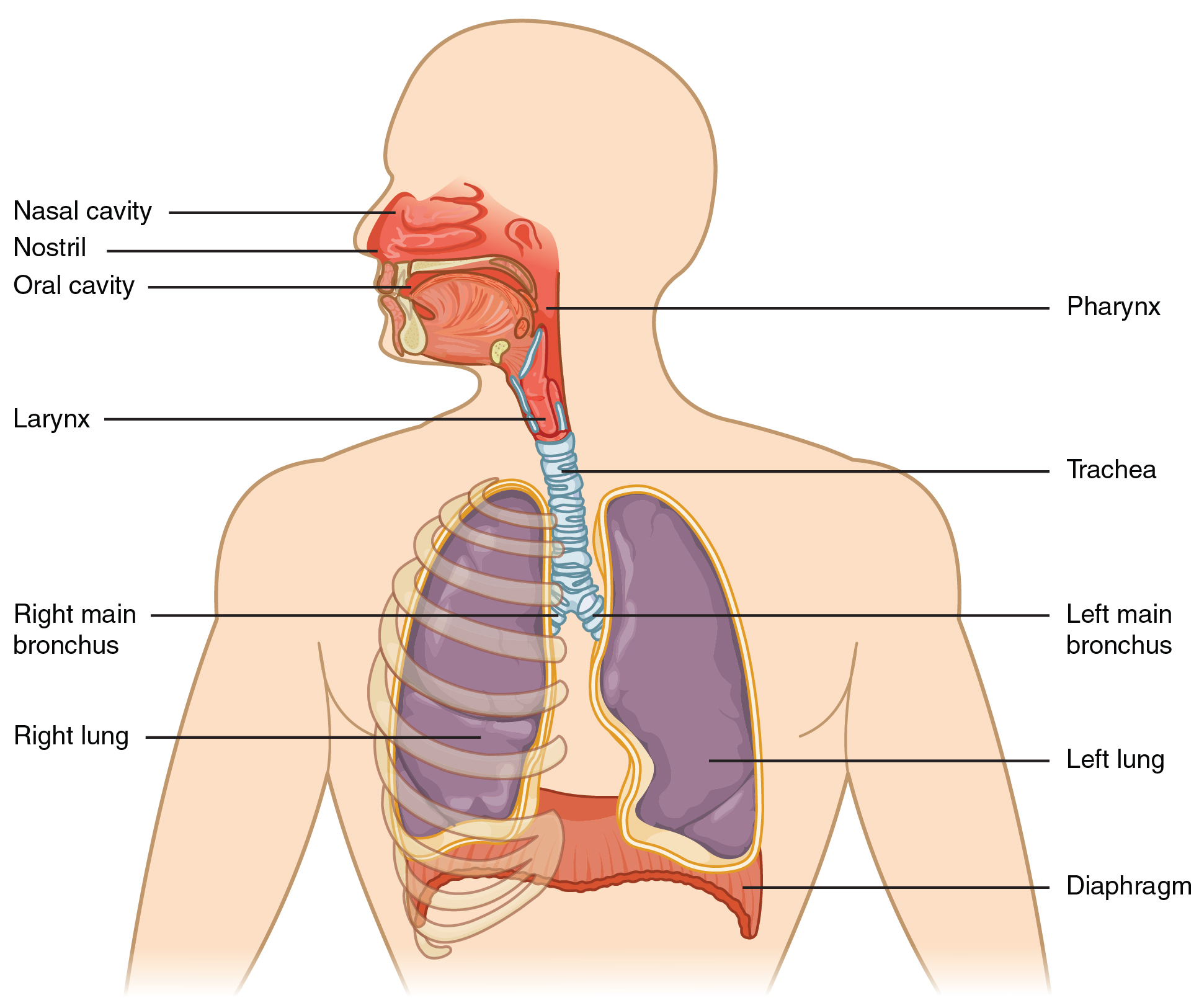
Maintaining a patent airway is a top priority and one of the “ABCs” of patient care (i.e., Airway, Breathing, and Circulation). Suctioning is often required in acute care settings for patients who cannot maintain their own airway due to a variety of medical conditions such as respiratory failure, stroke, unconsciousness, or postoperative care. The suctioning procedure is useful for removing mucus that may obstruct the airway and compromise the patient’s breathing ability.
To read more details about the respiratory system, see the “Respiratory Assessment” chapter.
Respiratory Failure and Respiratory Arrest
Respiratory failure and respiratory arrest often require emergency suctioning. Respiratory failure is a life-threatening condition that is caused when the respiratory system cannot get enough oxygen from the lungs into the blood to oxygenate the tissues, or there are high levels of carbon dioxide in the blood that the body cannot effectively eliminate via the lungs. Acute respiratory failure can happen quickly without much warning. It is often caused by a disease or injury that affects breathing, such as pneumonia, opioid overdose, stroke, or a lung or spinal cord injury. Acute respiratory failure requires emergency treatment. Untreated respiratory failure can lead to respiratory arrest.
Signs and symptoms of respiratory failure include shortness of breath (dyspnea), rapid breathing (tachypnea), rapid heart rate (tachycardia), unusual sweating (diaphoresis), decreasing pulse oximetry readings below 90%, and air hunger (a feeling as if you can't breathe in enough air). In severe cases, signs and symptoms may include cyanosis (a bluish color of the skin, lips, and fingernails), confusion, and sleepiness.
The main goal of treating respiratory failure is to ensure that sufficient oxygen reaches the lungs and is transported to the other organs while carbon dioxide is cleared from the body.[40] Treatment measures may include suctioning to clear the airway while also providing supplemental oxygen using various oxygenation devices. Severe respiratory distress may require intubation and mechanical ventilation, or the emergency placement of a tracheostomy may be performed if the airway is obstructed. For additional details about oxygenation and various oxygenation devices, go to the “Oxygen Therapy" chapter.
Tracheostomy
A tracheostomy is a surgically created opening called a stoma that goes from the front of the patient’s neck into the trachea. A tracheostomy tube is placed through the stoma and directly into the trachea to maintain an open (patent) airway. See Figure 22.2[41] for an illustration of a patient with a tracheostomy tube in place.
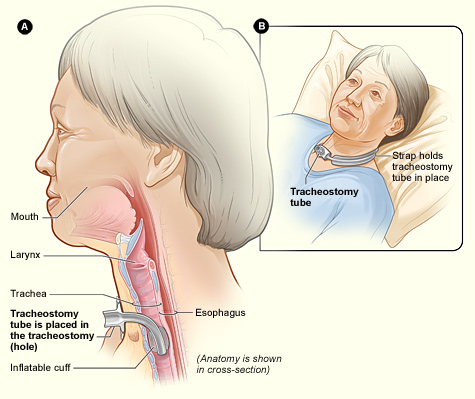
Placement of a tracheostomy tube may be performed emergently or as a planned procedure due to the following:
- A large object blocking the airway
- Respiratory failure or arrest
- Severe neck or mouth injuries
- A swollen or blocked airway due to inhalation of harmful material such as smoke, steam, or other toxic gases
- Cancer of the throat or neck, which can affect breathing by pressing on the airway
- Paralysis of the muscles that affect swallowing
- Surgery around the larynx that prevents normal breathing and swallowing
- Long-term oxygen therapy via a mechanical ventilator[42]
See Figure 22.3[43] for an image of the parts of a tracheostomy tube. The outside end of the outer cannula has a flange that is placed against the patient’s neck. The flange is secured around the patient’s neck with tie straps, and a split 4" x 4" tracheostomy dressing is placed under the flange to absorb secretions. A cuff is typically present on the distal end of the outer cannula to make a tight seal in the airway. (See the top image in Figure 22.3.) The cuff is inflated and deflated with a syringe attached to the pilot balloon. Most tracheostomy tubes have a hollow inner cannula inside the outer cannula that is either disposable or removed for cleaning as part of the tracheostomy care procedure. (See the middle image of Figure 22.3.) A solid obturator is used during the initial tracheostomy insertion procedure to help guide the outer cannula through the tracheostomy and into the airway. (See the bottom image of Figure 22.3.) It is removed after insertion and the inner cannula is slid into place.
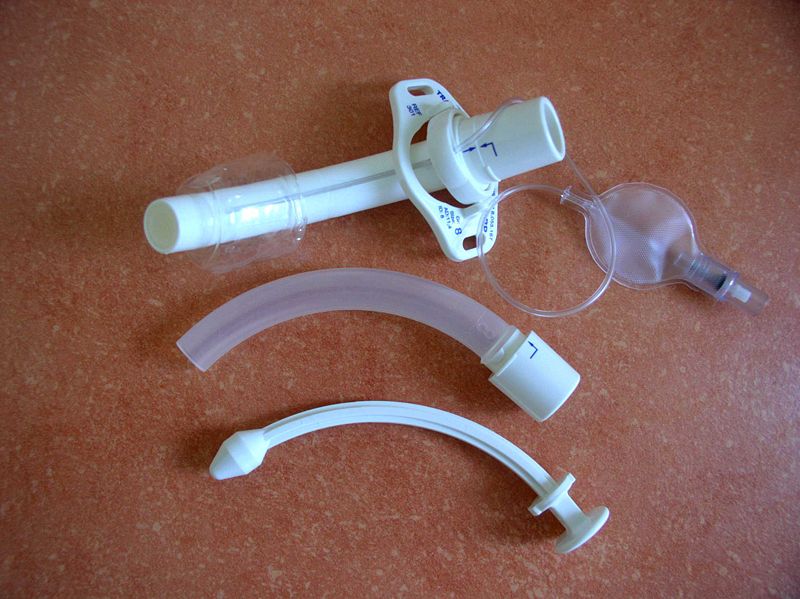
When a tracheostomy is placed, the provider determines if a fenestrated or unfenestrated outer cannula is needed based on the patient's condition. A fenestrated tube is used for patients who can speak with their tracheostomy tube in place. Under the guidance of a speech pathologist and respiratory therapist, the inner cannula is eventually removed from a fenestrated tube and the cuff deflated so the patient is able to speak. Otherwise, a patient with a tracheostomy tube is unable to speak because there is no airflow over the vocal cords, and alternative communication measures, such as a whiteboard, pen and paper, or computer device with note-taking ability, must be put into place by the nurse. Suctioning should never be performed through a fenestrated tube without first inserting a nonfenestrated inner cannula, or severe tracheal damage can occur. See Figure 22.4[44] for images of a fenestrated and nonfenestrated outer cannula.

Caring for a patient with a tracheostomy tube includes providing routine tracheostomy care and suctioning. Tracheostomy care is a procedure performed routinely to keep the flange, tracheostomy dressing, ties or straps, and surrounding area clean to reduce the introduction of bacteria into the trachea and lungs. The inner cannula becomes occluded with secretions and must be cleaned or replaced frequently according to agency policy to maintain an open airway. Suctioning through the tracheostomy tube is also performed to remove mucus and to maintain a patent airway.
Suctioning via the oropharyngeal (mouth) and nasopharyngeal (nasal) routes is performed to remove accumulated saliva, pulmonary secretions, blood, vomitus, and other foreign material from these areas that cannot be removed by the patient’s spontaneous cough or other less invasive procedures. Nasal and pharyngeal suctioning are performed in a wide variety of settings, including critical care units, emergency departments, inpatient acute care, skilled nursing facility care, home care, and outpatient/ambulatory care. Suctioning is indicated when the patient is unable to clear secretions and/or when there is audible or visible evidence of secretions in the large/central airways that persist in spite of the patient's best cough effort. Need for suctioning is evidenced by one or more of the following:
- Visible secretions in the airway
- Chest auscultation of coarse, gurgling breath sounds, rhonchi, or diminished breath sounds
- Reported feeling of secretions in the chest
- Suspected aspiration of gastric or upper airway secretions
- Clinically apparent increased work of breathing
- Restlessness
- Unrelieved coughing[45]
In emergent situations, a provider order is not necessary for suctioning to maintain a patient’s airway. However, routine suctioning does require a provider order.
For oropharyngeal suctioning, a device called a Yankauer suction tip is typically used for suctioning mouth secretions. A Yankauer device is rigid and has several holes for suctioning secretions that are commonly thick and difficult for the patient to clear. See Figure 22.5[46] for an image of a Yankauer device. In many agencies, Yankauer suctioning can be delegated to trained assistive personnel if the patient is stable, but the nurse is responsible for assessing and documenting the patient’s respiratory status.
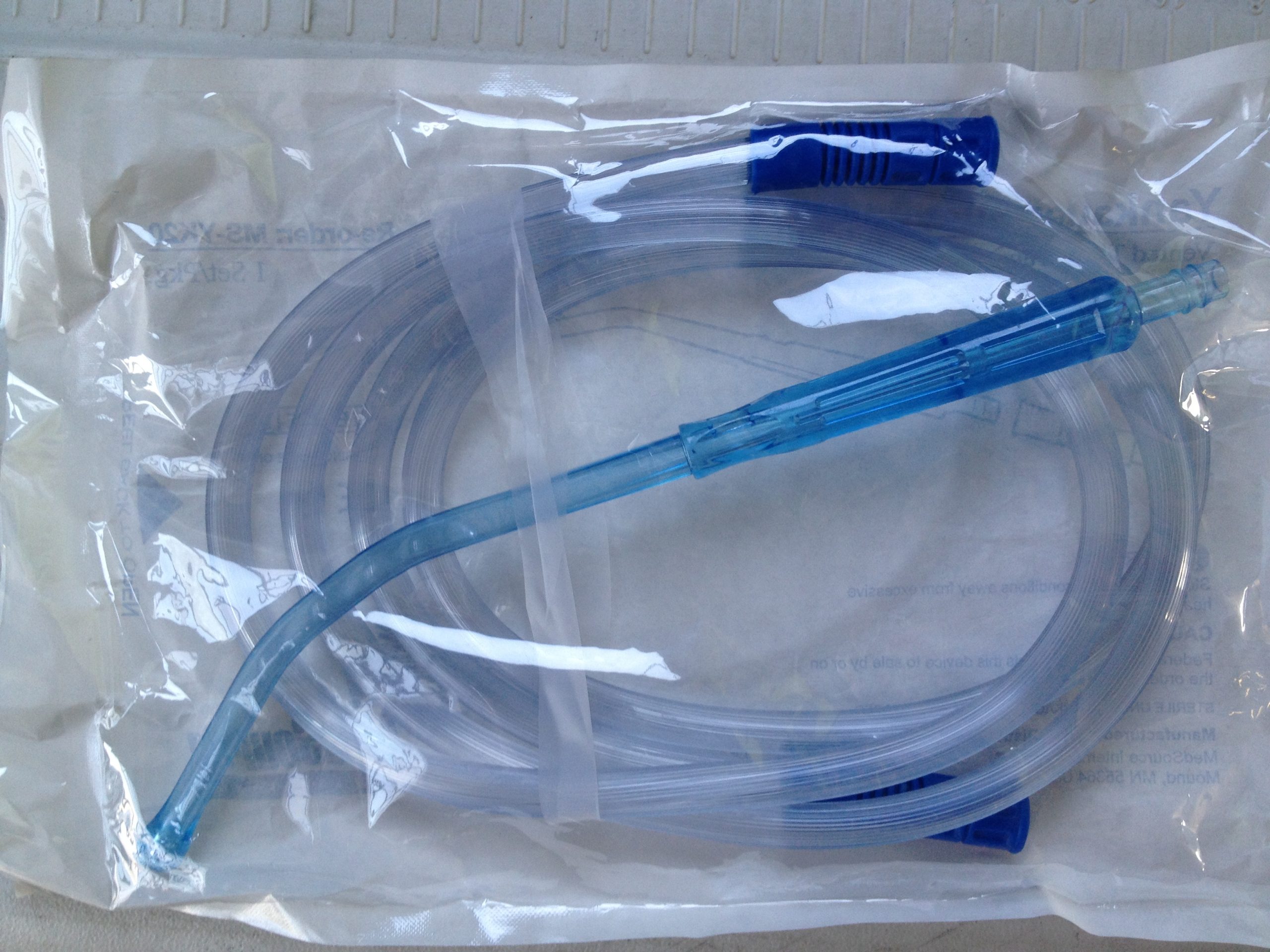
Nasopharyngeal suctioning removes secretions from the nasal cavity, pharynx, and throat by inserting a flexible, soft suction catheter through the nares. This type of suctioning is performed when oral suctioning with a Yankauer is ineffective. See Figure 22.6[47] for an image of a sterile suction catheter.
![“DSC_0210-150x150.jpg” by British Columbia Institute of Technology (BCIT) is licensed under CC BY 4.0. [/footnote] Access for free at https://opentextbc.ca/clinicalskills/chapter/5-7-oral-suctioning/ Photo of a sterile suction catheter being handled by a person wearing gloves](https://opencontent.ccbcmd.edu/app/uploads/sites/30/2024/08/DSC_0210-scaled-1.jpg)
Extension tubing is used to attach the Yankauer or suction catheter device to a suction canister that is attached to wall suction or a portable suction source. The amount of suction is set to an appropriate pressure according to the patient’s age. See Figure 22.7[48] for an image of extension tubing attached to a suction canister that is connected to a wall suctioning source.
![“DSC_0206-e1437445438554.jpg” by by British Columbia Institute of Technology (BCIT) is licensed under CC BY 4.0. [/footnote]. Access for free at https://opentextbc.ca/clinicalskills/chapter/5-7-oral-suctioning/ Photo showing tubing attaching suction canister to wall suction source](https://opencontent.ccbcmd.edu/app/uploads/sites/30/2024/08/DSC_0206-e1437445438554-scaled-1.jpg)
Follow agency policy regarding setting suction pressure. Pressure should not exceed 150 mm Hg because higher pressures have been shown to cause trauma, hypoxemia, and atelectasis. The following ranges are appropriate pressure according to the patient's age:
- Neonates: 60-80 mm Hg
- Infants: 80-100 mm Hg
- Children: 100-120 mm Hg
- Adults: 100-150 mm Hg
Checklist for Oropharyngeal or Nasopharyngeal Suctioning
Use the checklist below to review the steps for completion of “Oropharyngeal or Nasopharyngeal Suctioning.”
Steps
Disclaimer: Always review and follow agency policy regarding this specific skill.
- Gather supplies: Yankauer or suction catheter, suction machine or wall suction device, suction canister, connecting tubing, pulse oximeter, stethoscope, PPE (e.g., mask, goggles or face shield, nonsterile gloves), sterile gloves for suctioning with sterile suction catheter, towel or disposable paper drape, nonsterile basin or disposable cup, water soluble lubricant, normal saline or tap water.
- Perform safety steps:
- Perform hand hygiene.
- Check the room for transmission-based precautions.
- Introduce yourself, your role, the purpose of your visit, and an estimate of the time it will take.
- Confirm patient ID using two patient identifiers (e.g., name and date of birth).
- Explain the process to the patient.
- Be organized and systematic.
- Use appropriate listening and questioning skills.
- Listen and attend to patient cues.
- Ensure the patient’s privacy and dignity.
- Assess ABCs.
- Adjust the bed to a comfortable working height and lower the side rail closest to you.
- Position the patient:
- If conscious, place the patient in a semi-Fowler’s position.
- If unconscious, place the patient in the lateral position, facing you.
- Move the bedside table close to your work area and raise it to waist height.
- Place a towel or waterproof pad across the patient’s chest.
- Adjust the suction to the appropriate pressure:
- Adults and adolescents: no more than 150 mm Hg
- Children: no more than 120 mmHg
- Infants: no more than 100 mm Hg
- Neonates: no more than 80 mm Hg
For a portable unit:
- Adults: 10 to 15 cm Hg
- Adolescents: 8 to 15 cm Hg
- Children: 8 to 10 cm Hg
- Infants: 8 to 10 cm Hg
- Neonates: 6 to 8 cm Hg
- Put on a clean glove and occlude the end of the connection tubing to check suction pressure.
- Place the connecting tubing in a convenient location (e.g., at the head of the bed).
- Open the sterile suction package using aseptic technique. (NOTE: The open wrapper or container becomes a sterile field to hold other supplies.) Carefully remove the sterile container, touching only the outside surface. Set it up on the work surface and fill with sterile saline using sterile technique.
- Place a small amount of water-soluble lubricant on the sterile field, taking care to avoid touching the sterile field with the lubricant package.
- Increase the patient’s supplemental oxygen level or apply supplemental oxygen per facility policy or primary care provider order.
- Don additional PPE. Put on a face shield or goggles and mask.
- Don sterile gloves. The dominant hand will manipulate the catheter and must remain sterile.
- The nondominant hand is considered clean rather than sterile and will control the suction valve on the catheter.
- In the home setting and other community-based settings, maintenance of sterility is not necessary.
- With the dominant gloved hand, pick up the sterile suction catheter. Pick up the connecting tubing with the nondominant hand and connect the tubing and suction catheter.
- Moisten the catheter by dipping it into the container of sterile saline. Occlude the suction valve on the catheter to check for suction.
- Encourage the patient to take several deep breaths.
- Apply lubricant to the first 2 to 3 inches of the catheter, using the lubricant that was placed on the sterile field.
- Remove the oxygen delivery device, if appropriate. Do not apply suction as the catheter is inserted. Hold the catheter between your thumb and forefinger.
- Insert the catheter. For nasopharyngeal suctioning, gently insert the catheter through the naris and along the floor of the nostril toward the trachea. Roll the catheter between your fingers to help advance it. Advance the catheter approximately 5 to 6 inches to reach the pharynx. For oropharyngeal suctioning, insert the catheter through the mouth, along the side of the mouth toward the trachea. Advance the catheter 3 to 4 inches to reach the pharynx.
- Apply suction by intermittently occluding the suction valve on the catheter with the thumb of your nondominant hand and continuously rotate the catheter as it is being withdrawn.[50]
- Suction only on withdrawal and do not suction for more than 10 to 15 seconds at a time to minimize tissue trauma.
- Replace the oxygen delivery device using your nondominant hand, if appropriate, and have the patient take several deep breaths.
- Flush the catheter with saline. Assess the effectiveness of suctioning by listening to lung sounds and repeat, as needed, and according to the patient’s tolerance. Wrap the suction catheter around your dominant hand between attempts:
- Repeat the procedure up to three times until gurgling or bubbling sounds stop, and respirations are quiet. Allow 30 seconds to 1 minute between passes to allow reoxygenation and reventilation.[51]
- When suctioning is completed, remove gloves from the dominant hand over the coiled catheter, pulling them off inside out.
- Remove the glove from the nondominant hand and dispose of gloves, catheter, and the container with solution in the appropriate receptacle.
- Turn off the suction. Remove the supplemental oxygen placed for suctioning, if appropriate.
- Remove face shield or goggles and mask; perform hand hygiene.
- Perform oral hygiene on the patient after suctioning.
- Reassess the patient’s respiratory status, including respiratory rate, effort, oxygen saturation, and lung sounds.
- Assist the patient to a comfortable position, ask if they have any questions, and thank them for their time.
- Ensure safety measures when leaving the room:
- CALL LIGHT: Within reach
- BED: Low and locked (in lowest position and brakes on)
- SIDE RAILS: Secured
- TABLE: Within reach
- ROOM: Risk-free for falls (scan room and clear any obstacles)
- Perform hand hygiene.
- Document the procedure and related assessment findings. Report any concerns according to agency policy.
Sample Documentation
Sample Documentation of Expected Findings
Patient complaining of difficulty coughing up secretions. Order obtained for nasopharyngeal suctioning. Procedure explained to patient. Vitals signs prior to procedure: heart rate 88 regular, respiratory rate 28/minute, O2 saturation 88% on room air. Coarse rhonchi present over anterior upper airway. No cyanosis. Patient suctioned through left nare x 1 at 120 mm Hg with small amount clear, white, thick sputum obtained. Post-procedure vital signs: heart rate 78 regular, respiratory rate 18/minute, O2 saturation 94% room air. Lung sounds clear to auscultation and no cyanosis present.
Sample Documentation of Unexpected Findings
Patient complaining of difficulty expectorating secretions. Order obtained for nasopharyngeal suctioning and procedure explained to patient. Vital signs prior to procedure: heart rate 88 and regular, respiratory rate 28/minute, and O2 sat 88% room air. Coarse rhonchi present over anterior upper airway. No cyanosis. After first suctioning pass, patient coughing uncontrollably. Procedure stopped and emergency assistance requested from respiratory therapist. Post-procedure vital signs: heart rate 78 and regular, respiratory rate 18/minute, and O2 sat 94% room air. Course rhonchi remain over anterior upper airway but no cyanosis present. Dr. Smith notified and STAT order for chest X-ray received. Dr. Smith to be called with results.
Tracheostomy care is provided on a routine basis to keep the tracheostomy tube’s flange, inner cannula, and surrounding area clean and dry and to reduce the amount of bacteria entering the artificial airway, lungs, and maintain skin integrity. See Figure 22.9[52] for an image of a sterile tracheostomy care kit.
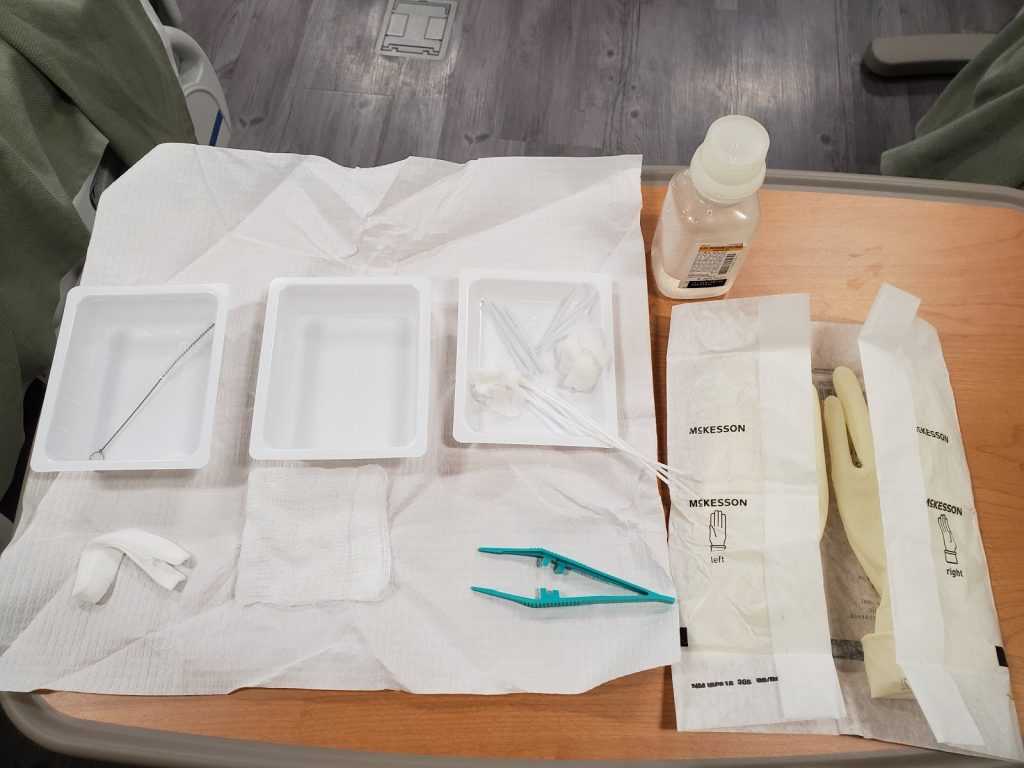
Replacing and Cleaning an Inner Cannula
The primary purpose of the inner cannula is to prevent tracheostomy tube obstruction. Many sources of obstruction can be prevented if the inner cannula is regularly cleaned and replaced. Some inner cannulas are designed to be disposable, while others are reusable for a number of days. Follow agency policy for inner cannula replacement or cleaning, but as a rule of thumb, inner cannula cleaning should be performed every 12-24 hours at a minimum. Cleaning may be needed more frequently depending on the type of equipment, the amount and thickness of secretions, and the patient’s ability to cough up the secretions.
Changing the inner cannula may encourage the patient to cough and bring mucus out of the tracheostomy. For this reason, the inner cannula should be replaced prior to changing the tracheostomy dressing to prevent secretions from soiling the new dressing. If the inner cannula is disposable, no cleaning is required.[53]
Checklist for Tracheostomy Care With a Reusable Inner Cannula
Use the checklist below to review the steps for completion of “Tracheostomy Care.”
Stoma site should be assessed and a clean dressing applied at least once per shift. Wet or soiled dressings should be changed immediately.[54] Follow agency policy regarding cleaning the inner cannula; it should be inspected at least twice daily and cleaned as needed.
Steps
Disclaimer: Always review and follow agency policy regarding this specific skill.
- Gather supplies: bedside table, towel, sterile gloves, pulse oximeter, PPE (i.e., mask, goggles, gown, or face shield), tracheostomy suctioning equipment, bag valve mask (should be located in the room), and a sterile tracheostomy care kit (or sterile cotton-tipped applicators, sterile manufactured tracheostomy split sponge dressing, sterile basin, normal saline, and a disposable inner cannula or a small, sterile brush to clean the reusable inner cannula).
- Perform safety steps:
- Perform hand hygiene.
- Check the room for transmission-based precautions.
- Introduce yourself, your role, the purpose of your visit, and an estimate of the time it will take.
- Confirm patient ID using two patient identifiers (e.g., name and date of birth).
- Explain the process to the patient and ask if they have any questions.
- Be organized and systematic.
- Use appropriate listening and questioning skills.
- Listen and attend to patient cues.
- Ensure the patient’s privacy and dignity.
- Assess ABCs.
- Raise the bed to waist level and place the patient in a semi-Fowler’s position.
- Verify that there is a backup tracheostomy kit available.
- Don appropriate PPE.
- Perform tracheal suctioning if indicated.
- Remove and discard the tracheostomy dressing. Inspect drainage on the dressing for color and amount and note any odor.
- Inspect stoma site for redness, drainage, and signs and symptoms of infection.
- Remove the gloves and perform proper hand hygiene.
- Open the sterile package and loosen the bottle cap of sterile saline.
- Don one sterile glove on the dominant hand.
- Open the sterile drape and place it on the patient’s chest.
- Set up the equipment on the sterile field.
- Remove the cap and pour saline in both basins with the ungloved hand (4"-6” above basin).
- Don the second sterile glove.
- Prepare and arrange supplies. Place pipe cleaners, trach ties, trach dressing, and forceps on the field. Moisten cotton applicators and place them in the third (empty) basin. Moisten two 4" x 4" pads in saline, wring out, open, and separately place each one in the third basin. Leave one 4" x 4" dry.
- With nondominant “contaminated” hand, remove the trach collar (if applicable) and remove (unlock and twist) the inner cannula. If the patient requires continuous supplemental oxygen, place the oxygenation device near the outer cannula or ask a staff member to assist in maintaining the oxygen supply to the patient.
- Place the inner cannula in the saline basin.
- Pick up the inner cannula with your nondominant hand, holding it only by the end usually exposed to air.
- With your dominant hand, use a brush to clean the inner cannula. Place the brush back into the saline basin.
- After cleaning, place the inner cannula in the second saline basin with your nondominant hand and agitate for approximately 10 seconds to rinse off debris. Repeat cleansing with brush as needed.
- Dry the inner cannula with the pipe cleaners and place the inner cannula back into the outer cannula. Lock it into place and pull gently to ensure it is locked appropriately. Reattach the preexisting oxygenation device.
- Clean the stoma with cotton applicators using one on the superior aspect and one on the inferior aspect.
- With your dominant, noncontaminated hand, moisten sterile gauze with sterile saline and wring out excess. Assess the stoma for infection and skin breakdown caused by flange pressure. Clean the stoma with the moistened gauze starting at the 12 o’clock position of the stoma and wipe toward the 3 o’clock position. Begin again with a new gauze square at 12 o’clock and clean toward 9 o’clock. To clean the lower half of the site, start at the 3 o’clock position and clean toward 6 o’clock; then wipe from 9 o’clock to 6 o’clock, using a clean moistened gauze square for each wipe. Continue this pattern on the surrounding skin and tube flange. Avoid using a hydrogen peroxide mixture because it can impair healing.[55]
- Use sterile gauze to dry the area.
- Apply the sterile tracheostomy split sponge dressing by only touching the outer edges.
- Replace trach ties as needed. (The literature overwhelmingly recommends a two-person technique when changing the securing device to prevent tube dislodgement. In the two-person technique, one person holds the trach tube in place while the other changes the securing device). Thread the clean tie through the opening on one side of the trach tube. Bring the tie around the back of the neck, keeping one end longer than the other. Secure the tie on the opposite side of the trach. Make sure that only one finger can be inserted under the tie.
- Remove the old tracheostomy ties.
- Remove gloves and perform proper hand hygiene.
- Provide oral care. Oral care keeps the mouth and teeth not only clean, but also has been shown to prevent hospital-acquired pneumonia.
- Lower the bed to the lowest position. If the patient is on a mechanical ventilator, the head of the bed should be maintained at 30-45 degrees to prevent ventilator-associated pneumonia.
- Assist the patient to a comfortable position, ask if they have any questions, and thank them for their time.
- Ensure safety measures when leaving the room:
- CALL LIGHT: Within reach
- BED: Low and locked (in lowest position and brakes on)
- SIDE RAILS: Secured
- TABLE: Within reach
- ROOM: Risk-free for falls (scan room and clear any obstacles)
- Perform hand hygiene.
- Document the procedure and related assessment findings. Report any concerns according to agency policy.
Sample Documentation
Sample Documentation of Expected Findings
Tracheostomy care provided with sterile technique. Stoma site free of redness or drainage. Inner cannula cleaned and stoma dressing changed. Patient tolerated the procedure without difficulties.
Sample Documentation of Unexpected Findings
Tracheostomy care provided with sterile technique. Stoma site is erythematous, warm, and tender to palpation. Inner cannula cleaned and stoma dressing changed. Patient tolerated the procedure without difficulties. Dr. Smith notified of change in condition of stoma at 1315 and stated would assess the patient this afternoon.
View the following YouTube videos from Santa Fe College for more information on tracheostomy care and suctioning:
Learning Activities
(Answers to “Learning Activities” can be found in the “Answer Key” at the end of the book. Answers to interactive activity elements will be provided within the element as immediate feedback.)
1. You are caring for a patient with a tracheostomy. What supplies should you ensure are in the patient's room when you first assess the patient?
2. Your patient with a tracheostomy puts on their call light. As you enter the room, the patient is coughing violently and turning red. Prioritize the action steps that you will take.
- Assess lung sounds
- Suction patient
- Provide oxygen via the trach collar if warranted
- Check pulse oximetry
![]()
Test your clinical judgment with an NCLEX Next Generation-style question: Chapter 22, Assignment 1.
![]()
Test your clinical judgment with an NCLEX Next Generation-style question: Chapter 22, Assignment 2.
Learning Activities
(Answers to “Learning Activities” can be found in the “Answer Key” at the end of the book. Answers to interactive activity elements will be provided within the element as immediate feedback.)
1. You are caring for a patient with a tracheostomy. What supplies should you ensure are in the patient's room when you first assess the patient?
2. Your patient with a tracheostomy puts on their call light. As you enter the room, the patient is coughing violently and turning red. Prioritize the action steps that you will take.
- Assess lung sounds
- Suction patient
- Provide oxygen via the trach collar if warranted
- Check pulse oximetry
Test your clinical judgment with an NCLEX Next Generation-style question: Chapter 22, Assignment 1.
Test your clinical judgment with an NCLEX Next Generation-style question: Chapter 22, Assignment 2.
Fenestrated cannula: Type of tracheostomy tube that contains holes so the patient can speak if the cuff is deflated and the inner cannula is removed.
Flange: The end of the tracheostomy tube that is placed securely against the patient’s neck.
Inner cannula: The cannula inside the outer cannula that is removed during tracheostomy care by the nurse. Inner cannulas can be disposable or reusable with appropriate cleaning.
Oropharyngeal suctioning: Suction of secretions through the mouth, often using a Yankauer device.
Outer cannula: The outer cannula placed by the provider through the tracheostomy stoma and continuously remains in place.
Suction canister: A container for collecting suctioned secretions that is attached to a suction source.
Suction catheter: A soft, flexible, sterile catheter used for nasopharyngeal and tracheostomy suctioning.
Tracheostomy: A surgically created opening that goes from the front of the neck into the trachea.
Tracheostomy dressing: A manufactured dressing used with tracheostomies that does not shed fibers, which could potentially be inhaled by the patient.
Yankauer suction tip: Rigid device used to suction secretions from the mouth.
Nurses access patients' veins to collect blood (i.e., perform phlebotomy) and to administer intravenous (IV) therapy. This section will describe several methods for collecting blood, as well as review the basic concepts of IV therapy.
Blood Collection
Nurses collect blood samples from patients using several methods, including venipuncture, capillary blood sampling, and blood draws from venous access devices. Blood may also be drawn from arteries by specially trained professionals for certain laboratory testing.
Venipuncture
Venipuncture involves the process of introducing a needle into a patient’s vein to collect a blood sample or insert an IV catheter. See Figure 23.1[58] for an image of venipuncture. Blood sampling with venipuncture may be initiated by nurses, phlebotomists, or other trained personnel. Venipuncture for collection of a blood sample is an important part of data collection to assess a patient’s health status. It is commonly performed to examine hematologic and immune issues such as the body’s oxygen-carrying capacity, infection, and clotting function. It is also useful for assessing metabolic and nutrition issues such as electrolyte status and kidney functioning.
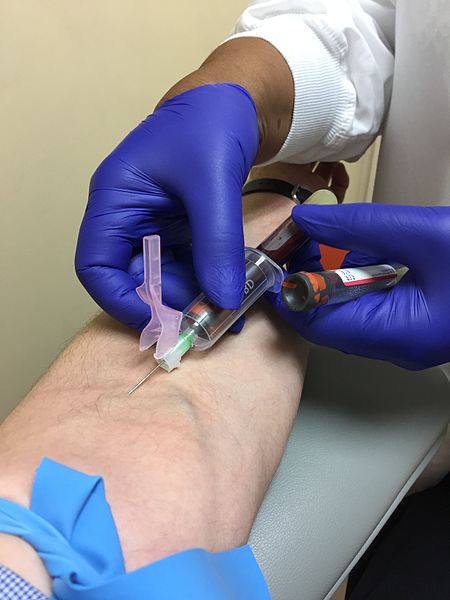
Blood collection is commonly performed via venipuncture from veins in the arms or hands. The most common sites for venipuncture are the large veins located on the antecubital fossa (i.e., the inner side of the elbow). These veins are often preferred for venipuncture because their larger size increases their ability to withstand repetitive blood sampling. However, these veins are not preferred for intravenous therapy due to the mechanical obstruction that can occur in the IV catheter when the elbow joint is contracted.
To perform the skill of venipuncture, the nurse performs many similar steps that occur with IV cannulation. The process of venipuncture for blood sample collection is outlined in the Open RN Nursing Advanced Skills "Perform Venipuncture Blood Draw" checklist.
Blood Samples From Central Venous Access Devices
Blood may also be collected by nurses from a patient's existing central venous access device (CVAD). A CVAD is a type of vascular access that involves the insertion of a catheter into a large vein in the arm, neck, chest, or groin.[59]
CVADs are discussed in more detail in the Open RN Nursing Advanced Skills "Manage Central Lines" chapter that also contains the "Obtain a Blood Sample From a CVAD" checklist.
Capillary Blood Sampling
Nurses also collect small amounts of blood for testing via capillary blood sampling. Capillary blood testing occurs when blood is collected from capillaries located near the surface of the skin. Capillaries in the fingers are used for testing in adults whereas capillaries in the heels are used for infants. An example of capillary blood testing is bedside glucose testing. See Figure 23.2[60] for an image of capillary blood glucose testing.
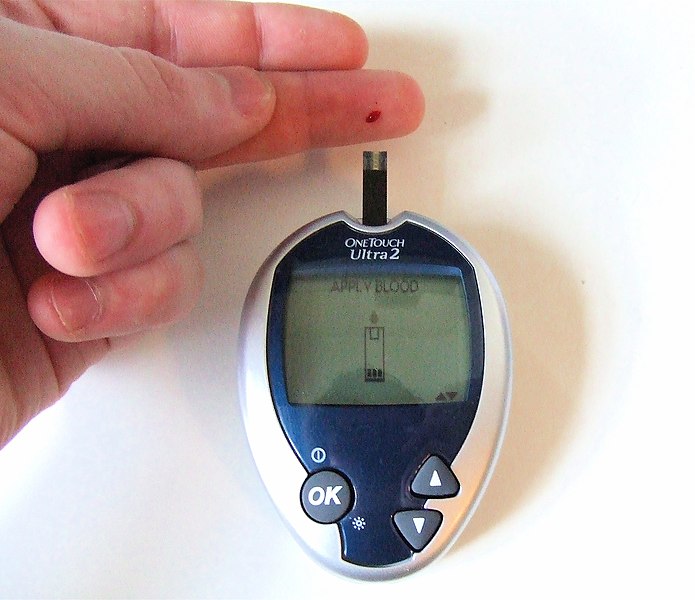
Capillary blood testing is typically used when repetitive sampling is needed. However, not all blood tests can be performed on capillary blood, and some clinical conditions make capillary blood testing inappropriate, such as when a patient is hypotensive with limited venous return.
Review how to perform capillary blood glucose testing in the "Blood Glucose Monitoring" section of the "Specimen Collection" chapter of Open RN Nursing Skills.
Arterial Blood Sampling
Arterial blood sampling occurs when blood is obtained via puncture into an artery by specially trained registered nurses and other health care personnel, such as respiratory therapists, physicians, nurse practitioners, and physician assistants. Arterial blood collection is most commonly performed to assess the body’s acid-base balance in a diagnostic test called an arterial blood gas. (For more information on arterial blood gas interpretation, please review Open RN Nursing Fundamentals Chapter 15). The most common access site for arterial blood sampling is the radial artery. See Figure 23.3[61] for an image of arterial blood sampling. Arterial blood tests are known to be more painful for the patient than venipuncture and have a higher risk of complications such as bleeding and arterial occlusion with subsequent ischemia to the area distal to the puncture.
Arterial Lines
For patients who require repetitive arterial blood sampling or are hemodynamically unstable, an arterial line may be inserted by specially trained personnel. Arterial lines are specialized tubes that are inserted and maintained in an artery to assist with continuous blood pressure monitoring. They also allow for repeated blood sampling without repetitive puncture, thus decreasing the amount of discomfort for the patient. The radial artery is the most common site used for arterial lines. Nurses must not confuse arterial lines with peripheral or central vein access devices. Arterial lines can be distinguished from venous lines by their specialized pressure tubing, which is firm and non-pliable and is connected to a pressure bag to maintain constant pressurized fluid in the tubing. Medications, fluid boluses, and maintenance IV fluids must never be infused through an arterial line. See Figure 23.3[62] for an image of arterial lines. The condition of the arterial access site, as well as perfusion of the patient's hand, is continually monitored when an arterial line is in place to prevent complications.

Intravenous Therapy
In addition to collecting blood samples, nurses also access patients' veins to administer intravenous therapy.Intravenous therapy (IV therapy) involves the administration of substances such as fluids, electrolytes, blood products, nutrition, or medications directly into a patient's vein. The intravenous route is preferred to administer fluids and medications when rapid onset of the medication or fluid is needed. The direct administration of medication into the bloodstream allows for a more rapid onset of medication actions, restoration of hydration, and correction of nutritional deficits. IV therapy is often used to restore fluids and/or resolve electrolyte imbalances more efficiently than what would be achieved via the oral route.
Fluid Balance
Fluid balance is an important part of optimal cellular functioning, and administration of fluids via the venous system provides an efficient way to quickly correct fluid imbalances. Additionally, many individuals who are physically unwell may not be able to tolerate fluids administered through their gastrointestinal tract, so IV administration is necessary. When administering IV therapy, the nurse needs to understand the nature of the solution being administered and how it will affect the patient's condition.
When patients experience deficient fluid volume, intravenous (IV) fluids are often used to restore fluid to the intravascular compartment or to facilitate the movement of fluid between compartments through the process of osmosis. There are three types of IV fluids: isotonic, hypotonic, and hypertonic.[63]
Review movement of fluid between compartments of the body in the "Basic Fluid and Electrolyte Concepts" section of the "Fluids and Electrolytes" chapter in Open RN Nursing Fundamentals.
Isotonic Solutions
Isotonic solutions are IV fluids that have a similar concentration of dissolved particles as found in the blood. Examples of isotonic IV solutions are 0.9% normal saline (0.9% NaCl) or lactated ringers (LR). Because the concentration of isotonic IV fluid is similar to the concentration of blood, the fluid stays in the intravascular space, and osmosis does not cause fluid movement between cells. See Figure 23.4[64] for an illustration of isotonic IV solution administration that does not cause osmotic movement of fluid.
Isotonic solutions are used to treat fluid volume deficit (also called hypovolemia) to replace extracellular fluid that has been lost due to bleeding, dehydration, shock, burns, trauma, and gastrointestinal tract fluid loss (such as diarrhea). IV therapy with isotonic fluids will increase a patient's blood pressure. However, infusion of too much isotonic fluid can cause excessive fluid volume (also referred to as hypervolemia) and must be used with caution in patients with hypertension, heart failure, and renal disease due to the potential for fluid overload.[65]
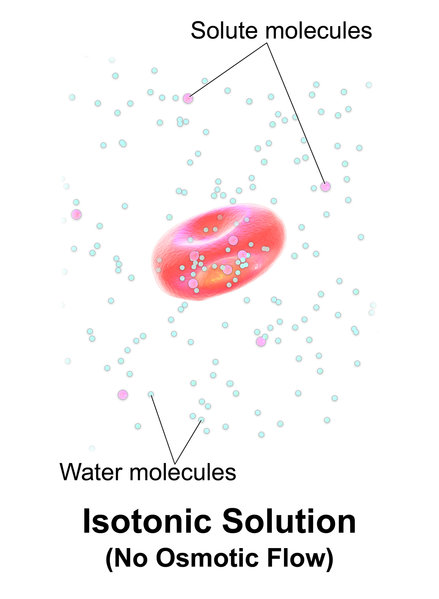
Hypotonic Solutions
Hypotonic solutions have a lower concentration of dissolved solutes than blood. An example of a hypotonic IV solution is 0.45% normal saline (0.45% NaCl). Another example of hypotonic fluid is dextrose 5% in water (D5W). D5W is isotonic in the bag but becomes hypotonic after the dextrose is rapidly metabolized by the body.
When hypotonic IV solutions are infused, it results in a decreased concentration of dissolved solutes in the blood as compared to the intracellular space. This imbalance causes osmotic movement of water from the intravascular compartment into the intracellular space. For this reason, hypotonic fluids are used to treat cellular dehydration. See Figure 23.5[66] for an illustration of the osmotic movement of fluid into a cell when a hypotonic IV solution is administered, causing lower concentration of solutes (pink molecules) in the bloodstream compared to within the cell.[67]
Hypotonic solutions are used for patients whose cells have become dehydrated, such as during diabetic ketoacidosis (DKA) or hyperosmolar hyperglycemia, and fluids must be pushed back into the cells. However, if too much fluid moves out of the intravascular compartment into the cells, cerebral edema, worsening hypovolemia, and hypotension can occur. Therefore, patient status should be monitored carefully when hypotonic solutions are infused.[68]

Hypertonic Solutions
Hypertonic solutions have a higher concentration of dissolved particles than blood. An example of hypertonic IV solution is 3% normal saline (3% NaCl). When infused, hypertonic fluids cause an increased concentration of dissolved solutes in the intravascular space compared to the cells. This causes the osmotic movement of water out of the cells and into the intravascular space to dilute the solutes in the blood. See Figure 23.6[69] for an illustration of osmotic movement of fluid out of a cell when hypertonic IV fluid is administered due to a higher concentration of solutes (pink molecules) in the bloodstream compared to the cell.
Hypertonic solutions move water out of the cells of the body and into the bloodstream. They are commonly used for patients with cerebral edema, severe hyponatremia, or some types of post-op patients. Hypertonic solutions must be used very cautiously due to potentially rapid side effects of fluid overload resulting in pulmonary edema, so they are typically administered in intensive care units (ICU). Hypertonic fluids should not be administered to patients with DKA because it will worsen their cellular dehydration.
When administering hypertonic fluids, it is essential to monitor for signs of fluid overload, such as significantly elevated blood pressure and difficulties breathing. Additionally, if hypertonic solutions with sodium are given, the patient's serum sodium level should be closely monitored.[70]
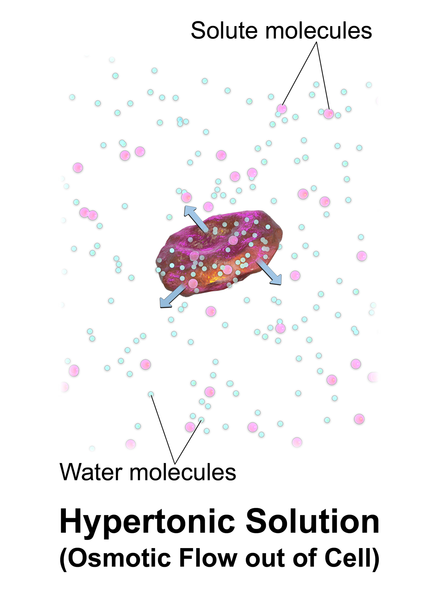
See Figure 23.7[71] for an illustration comparing how different types of IV solutions affect red blood cell size.
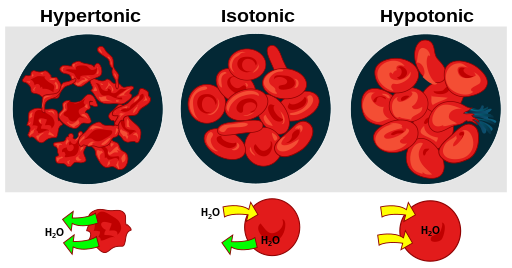
IV fluids are considered medications. As with all medications, nurses must check the rights of medication administration according to agency policy before administering IV fluids. What began as five rights of medication administration has been extended to eight rights according to the American Nurses Association. These eight rights include the following[72]:
- Right Patient
- Right Medication
- Right Dose
- Right Time
- Right Route
- Right Documentation
- Right Reason
- Right Response
Nurses also check for patient allergies, expiration date of the fluid, and compatibility of the fluid with any other fluids, medications, or blood products being administered intravenously. With any IV infusion, it is important for the nurse to pay close attention to the provider's order and make sure that it contains the specific type of fluid, any additives or medications, amount to be infused, rate of infusion, and the length of time that the therapy should continue. The nurse should also carefully assess a patient's hydration status and oral intake to ensure that IV fluids are stopped appropriately as a patent's condition changes. For example, weight should be assessed daily for patients receiving IV fluids to monitor for fluid overload.
Review how to check the rights of medication administration in the “Administration of Enteral Medications” chapter of Open RN Nursing Skills.
Electrolyte Imbalance
In addition to rapidly improving hydration status, IV fluids may also be administered to rapidly correct electrolyte imbalances. Infusing fluids with electrolytes such as potassium, calcium, and magnesium can correct electrolyte imbalances more rapidly and effectively than by oral supplementation. However, nurses must collaborate with the interprofessional team to identify medications that should and should not be given through peripheral veins. Current standards of care consider continuous peripheral infusion therapy of electrolytes to be inappropriate because of potential vascular endothelial damage. Ideally, peripheral IV therapy should be isotonic and consistent with physiological pH; otherwise, central venous access should be used.[73]
Electrolytes administered via the IV route must always be administered cautiously at the correct infusion rate because over supplementation can be deadly. For example, potassium infusions administered too rapidly into a patient's system can cause sudden cardiac arrest.
Blood Administration
Blood and blood components are administered by registered nurses via IV infusion, typically through larger sized IV catheters. Blood and blood components are transfused through a special transfusion administration set that has a filter designed to retain potentially harmful particles. Specific procedures for verifying the correct patient and correct blood product are performed prior to transfusion to prevent transfusion reactions that can be life-threatening. Administration of blood and blood components, including the use of infusion devices and ancillary equipment, and the identification, evaluation, and reporting of adverse events related to transfusion are established in agency policies, procedures, and/or practice guidelines. Read more information about blood administration in the "Administer Blood Products" chapter in Open RN Nursing Advanced Skills.
Nutrition
Nutritional therapy can be administered through an intravenous route for patients who do not have an adequately functioning gastrointestinal tract and/or are unable to take in food or fluids appropriately. Peripheral nutrition may be ordered through a peripheral IV site for nutritional needs such as albumin replacement.
Total parenteral nutrition (TPN) may be ordered for a patient based on their specific electrolyte and/or nutritional needs. TPN is a very concentrated solution that must be administered via a central line. Central lines are placed in a larger vessel rather than a smaller, peripheral vessel. Accessing a central vessel requires additional training and expertise to prevent complications with insertion and is further discussed in the Open RN Nursing Advanced Skills "Manage Central Lines” chapter. If a nurse receives an order for TPN therapy for a patient who does not have central line access, the order should be clarified with the prescribing provider.
Medications
The IV route is preferred for the administration of many medications when immediate onset is required. For example, many types of pain medications can be given directly into the bloodstream with a much more rapid onset of action than if they were to be administered orally. Rapid relief of pain can be achieved in minutes rather than hours required for oral medications to reach their peak. Rapid onset can also be achieved with other medications such as those used to treat cardiac emergencies or severe allergic reactions to quickly restore patients to optimal body functioning. Additional information about IV administration of medications is discussed in the Open RN Nursing Advanced Skills "Administer IV Push Medications” chapter.
IV Administration Equipment
Intravenous (IV) substances are administered through flexible plastic tubing called an IV administration set. The IV administration set connects the bag of solution to the patient’s IV access site. There are two major types of IV administration sets: primary administration sets and secondary administration sets. Administration sets require routine replacement to prevent infection. Follow agency policy regarding tubing changes before initiating a new bag of fluid or medications. See a summary of general guidelines for IV therapy and administration equipment in the box at the end of this section.
Primary Administration Sets
Primary administration sets can be used to infuse continuous or intermittent fluids, electrolytes, or medications. These substances may be administered by infusion pump or by gravity, and each method requires its own type of administration set.
Primary fluids are typically administered using an IV pump. An IV pump is the safest method of administration to ensure specific amounts of fluid are administered. The rate of infusion through an IV pump is typically calculated in mL/hour.
For infusion by gravity, a primary IV administration set can be a macro-drip or a micro-drip solution set. Macro-drip sets are used for routine primary infusions for adults. Micro-drip IV tubing is used in pediatric or neonatal care where small amounts of fluids are administered over a long period of time. A macro-drip infusion set delivers fluid at 10, 15, or 20 drops per milliliter, whereas a micro-drip infusion set delivers 60 drops per milliliter. The drop factor is located on the packaging of the IV tubing and is important to verify when calculating medication administration rates.
Primary IV administration sets consist of the following parts:
- Sterile spike: Used to spike the IV fluid bag and must be kept sterile.
- Roller clamp: Used to regulate the speed or stop an infusion by gravity.
- Drip chamber: Allows air to rise out from a fluid so that it is not passed onto the patient. The drip chamber should be kept ¼ to ½ full of solution. When setting a rate by gravity to "drops per minute," the dripping from this chamber is counted.
- Backcheck valve: Prevents fluid or medication from travelling up into the primary IV bag.
- Access ports: Used to infuse secondary medications and to administer IV push medications. These may also be referred to as “Y ports.”
Secondary Administration Sets
Secondary IV administration sets are used to intermittently administer a secondary medication, such as an antibiotic, while the primary IV is also running. Secondary IV tubing is shorter in length than primary tubing and is connected to a primary line via an access port above the infusion pump. The infusion pump is then set at the prescribed secondary infusion rate while the secondary medication is administered. By hanging the secondary medication bag higher than the primary bag, gravity pulls fluid from the secondary bag until it is empty rather than the primary bag.
Secondary medications may be “piggybacked” into primary infusion lines so the solution from the primary fluid line can be used to prime the secondary tubing. To prime the secondary tubing, after the secondary tubing is connected to the primary tubing, the bag connected to the secondary tubing is held lower than the primary bag, causing fluid from the primary tubing to backflow up the secondary tubing. This eliminates air from the secondary tubing.
See Figure 23.8[74] for an illustration of the setup of primary and secondary administration sets for primary administration of fluids and secondary administration of medication by gravity. See Figure 23.9[75] for an image of an IV infusion pump.
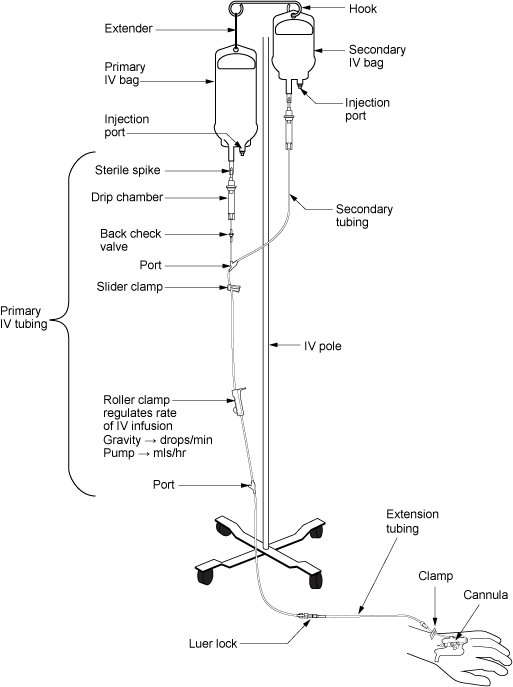

Priming IV Tubing
Primary administration sets, secondary administration sets, and extension tubing must be primed with IV solution to prevent air from entering the patient's circulatory system and causing an air embolism. Priming refers to the process of filling the IV tubing with IV solution prior to attaching it to the patient. Review steps for setting up and priming primary and secondary administration sets using the information in the following box.
Review checklists of steps for "Primary IV Solution Administration" and "Secondary IV Solution Administration" in the "IV Therapy Management" chapter of Open RN Nursing Skills.
Infection Control
Aseptic technique must be maintained throughout all IV therapy procedures, including initiation of IV access, preparing and maintaining IV equipment, administering IV fluids and medications, and discontinuing an IV system. Hand hygiene and strict aseptic technique must be performed when handling all IV equipment. These standards can be reviewed in the “Aseptic Technique” chapter. Additionally, if an IV catheter or IV administration set should become contaminated by contact with a nonsterile surface, it should be replaced with a new one to prevent introducing bacteria or other contaminants into the system.
Types of Venous Access
There are several types of venous access devices used to administer IV therapy that are categorized as peripheral devices or central devices. Venous access device selection is tailored to each patient's needs and to the type, duration, and frequency of infusion.
Peripheral Devices
Peripheral venous access devices are commonly used for short-term IV therapy in the hospital setting. A peripheral IV is an intravenous catheter inserted by percutaneous venipuncture into a peripheral vein and held in place with a sterile transparent dressing. The transparent dressing helps to keep the site sterile, prevents accidental dislodgement, and allows the nurse to visualize the insertion site through the dressing. A securement device may be added to prevent accidental dislodgement.
The patient’s upper extremities (hands and arms) are the preferred sites for insertion. However, a potential limitation of using the hand veins is they are smaller than the cephalic, basilic, or brachial veins in the arm. If the patient requires rapid infusions where a larger gauge IV is warranted, the larger veins in the upper arm should be considered.
Peripheral IVs are used for short-term infusions of fluids, medications, or blood. Peripheral IVs are easy to monitor and can be inserted at the bedside by nurses and other trained professionals. After IV access has been obtained, the hub of an intravenous catheter is attached to a short extension set or a primary IV administration set. Luer lock connectors on the extension tubing and/or administration sets permit syringes to be attached to administer medications or fluid flushes.
Saline lock refers to the use of a short extension set that allows IV access without requiring ongoing IV infusions. When not in use, the lock is flushed with saline according to agency policy and clamped to ensure the site remains sterile and blood does not flow out of the extension tubing. See Figure 23.10[76] for an image of a saline lock.

If the patient requires continuous infusion of IV fluids, the extension tubing from the IV catheter is connected to a primary IV administration set. The IV tubing can be run through an infusion pump to administer fluids or medications at a programmed rate of infusion (typically calculated in mL/hour) or via gravity by setting a drip rate with the roller clamp (typically calculated at drops/minute). Manufacturers list the drop rate on the IV packaging. Because of the risk of error that can occur with infusion by gravity, many agencies require the use of an infusion pump to ensure correct flow rate.
Contraindications to Peripheral IV Access Sites
Before inserting a peripheral IV, the patient should be assessed for contraindications related to insertion sites in the upper extremities. For example, patients who have a history of lumpectomy or mastectomy, an arteriovenous fistula, or current lymphedema often have restrictions that prohibit venipuncture into the affected extremity.[77] Additionally, deep vein thrombosis (DVT), fractures, contractures, or extensive scarring may also prohibit the placement of a peripheral IV. Hospitalized patients may have signage or a bracelet stating "limb alert" to alert heath care professionals to these conditions.
Midline Peripheral Catheters
Midline peripheral catheters have a larger catheter (i.e., 16-18 gauge) that allows for rapid infusions. Insertion is ultrasound-guided and can be inserted by RNs with additional training or other trained professionals. Midline catheters are typically inserted into the basilic, cephalic, or brachial veins of the upper arm with the tip placed near the level of the axilla. They are much longer and inserted deeper than a peripheral IV, but do not extend into a central vessel, so they are not considered a central line. Therefore, they have a lower risk of infection than central venous access. Any medication that can be administered through a peripheral line can be administered via a midline peripheral catheter. They can also be used for longer duration than traditional peripheral venous access, which is ideal for patients needing extended hospital stays or IV access. Based on agency policy, midline catheters may also be used for blood sample collection, thus limiting the number of venipunctures a patient receives. Site care for a midline peripheral catheter is similar to a peripheral IV dressing change.[78],[79]
Central Venous Access Devices
A central venous access device (CVAD) is a type of vascular access established by specially trained registered nurses and other health care personnel. It involves the insertion of a tube into a vein in the neck, chest, or groin and threaded into a central vein (most commonly the internal jugular, subclavian, or femoral) and advanced until the tip of the catheter resides within the inferior vena cava, superior vena cava, or right atrium.[80] Only specially trained health professionals may insert central venous access devices, but nurses provide routine care of CVADs, including dressing changes. See Figure 23.11[81] for an image of a central line requiring a dressing change.
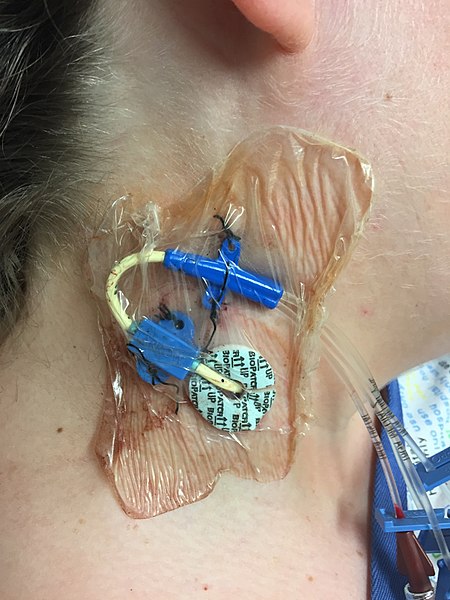
A central venous access device can be left in for longer periods of time and is useful for administering concentrated medications and fluids, such as TPN or hyperosmotic fluids, that would be otherwise irritating to smaller peripheral veins. However, central venous access devices have an increased risk for the development of bloodstream infections, so strict sterile technique is required during insertion, and aseptic technique is used for maintenance. Central venous access devices are further discussed in the "Manage Central Lines" chapter of Open RN Nursing Advanced Skills.
Peripheral Inserted Central Catheters
A peripheral inserted central catheter (PICC) is a thin, flexible tube inserted into a vein in the upper arm and guided into the superior vena cava. It is used to give intravenous fluids, blood transfusions, chemotherapy, and other medications requiring a central line. It can also be used for blood sampling. A PICC may stay in place for weeks or months and helps avoid the need for repeated needlesticks. PICC lines are further discussed in the "Manage Central Lines" chapter of Open RN Nursing Advanced Skills.
General Guidelines for IV Therapy
The following are general guidelines for peripheral IV therapy[82]:
- IV fluid therapy is ordered by a provider. The order must include the type of solution or medication, total amount of fluid, rate of infusion, duration, date, and time.
- IV therapy is an invasive procedure. Significant complications can occur if the wrong amount of IV fluids or incorrect medication is given or if aseptic technique is not strictly followed.
- Nurses must understand the indications and duration for IV therapy for each patient. Practice guidelines recommend that patients receiving IV therapy for more than six days should be assessed for an intermediate or long-term device such as a central venous access device (CVAD).
- Hospitalized patients may have an order for a small hourly infusion rate, such as 10-20 mL/hour, historically referred to in practice as a "to keep open" (TKO) or "keep vein open" (KVO) rate.
- IV administration sets require routine replacement to promote patient safety and reduce the risk of infection. Primary and secondary continuous administration sets used to administer solutions other than lipids, blood, or blood products are typically changed every 96 hours, or up to every 7 days, as directed by agency policy and/or the manufacturer’s instructions. Administration sets should also be changed if contamination or compromise in the integrity of the product or system is suspected. Secondary administration sets that are detached from a primary administration set are typically changed every 24 hours or as directed by agency policy. Administration sets should be labelled according to agency policy with the date of initiation or the date of change indicated.[83]
To prepare for intravenous therapy administration, the nurse should collect important subjective and objective assessment information from the patient.
Subjective Assessment
When performing the subjective assessment, the nurse should begin by focusing on data collection that may signify a potential complication if a patient receives IV infusion therapy. The nurse should begin by identifying if the patient has medication allergies or a latex allergy. The patient’s history should also be considered with special attention given to those with known congestive heart failure (CHF) or chronic kidney disease (CKD) because they are more susceptible to developing fluid overload. Additionally, the patient should be asked if they have any pain or discomfort in their IV access site now or during the infusion of medications or fluids.
Life Span Considerations
The needs and characteristics of special patient populations, including physiologic, developmental, communication/cognitive ability, and/or safety requirements, are identified and addressed in the planning, insertion, removal, care, management, and monitoring of vascular access devices (VADs) and with administration of infusion therapy.[84]
Children
Safety measures for a child with an IV infusion include assessing the IV site every hour for patency. Infused volumes and signs of fluid overload should be carefully assessed and documented frequently per agency policy.
Joint stabilization may be applied to deter the child from tampering with the IV site or tubing. However, it should be applied in a manner that permits visual inspection and assessment of the vascular access site and the vascular pathway, and it does not exert pressure that will cause circulatory constriction, pressure injury, or nerve damage in the area of flexion or under the device. Additionally, it should be removed periodically for assessment of circulatory status, range of motion and function, and skin integrity. Wooden tongue depressors should not be used as joint stabilization devices in preterm infants or immunocompromised individuals due to the risk of a fungal infection.[85]
Additionally, the tubing should be well-secured, and the dressing should remain free from moisture so the IV site is not compromised. Be aware that mobile children will require guidance to ensure that the tubing is not obstructed if they sit or lie on the tubing accidentally.
Older Adults
Nurses must recognize physiologic changes associated with the aging process and its effect on immunity, drug dosage and volume limitations, pharmacologic actions, interactions, side effects, monitoring parameters, and response to infusion therapy. Anatomical changes, including loss of thickness of the dermal skin layer, thickening of the tunica intima/media, and loss of connective tissue, contribute to vein fragility and present challenges in vascular access. Nurses must assess for any changes in cognitive abilities, dexterity, and the ability to communicate or learn (e.g., changes in vision, hearing, speech) that impact IV therapy.[86]
Older adults with an IV infusion should be frequently monitored for the development of fluid volume overload. Signs of fluid volume overload include elevated blood pressure and respiratory rate, decreased oxygen saturation, peripheral edema, fine crackles in the posterior lower lobes of the lungs, or signs of worsening heart failure. Additionally, older adults have delicate venous walls that may not withstand rapid infusion rates. It is important to monitor the IV site patency carefully when infusing large amounts of fluids at faster rates and appropriately modify the infusion rate.
Objective Assessment
Follow agency policy and procedures regarding IV therapy assessment and documentation. Current infusion standards indicate the venous access device site, the entire infusion system, and the patient should be assessed for signs of complications at a frequency dependent on a variety of factors, including the patient's age, condition, and cognition; the type and frequency of the intravenous fluid/medication; and the health care setting. In inpatient and nursing facilities, peripherally inserted IVs should be assessed at least every 4 hours with increased frequency of assessment every 1 to 2 hours for patients who are critically ill, sedated, or have cognitive deficits, and hourly for neonatal/pediatric patients and patients receiving infusions of vesicant medications.[87]
The entire IV infusion system, from the patient's IV insertion site and dressing to the IV solution container, is routinely assessed by the nurse for system integrity, infusion accuracy, identification of complications, and expiration dates throughout the course of treatment. The IV site should be free of redness, pallor, swelling, coolness, or warmth to the touch and the IV infusion should flow freely.[88]
The nurse should also be aware of different types of intravenous access that may be used for an infusion. For example, a peripherally inserted central catheter (PICC) looks similar to intravenous access but requires different assessment and monitoring as a central line. Please review Table 23.3 to consider the expected and unexpected assessment findings that may occur with peripheral IV therapy.
Table 23.3 Expected Versus Unexpected Findings With IV Therapy
| Assessment | Expected Findings | Unexpected Findings (document and notify provider if a new finding*) |
|---|---|---|
| Inspection | IV site free of redness, swelling, tenderness, coolness, or warmth to touch | IV site with redness, swelling, tenderness, coolness, or warmth to the touch |
| Patency | IV fluid flows freely | IV fluid does not flow; patient reports pain during flush |
| *CRITICAL CONDITIONS to report immediately | Notify the HCP if there is redness, warmth, or blisters at the site |
To prepare for intravenous therapy administration, the nurse should collect important subjective and objective assessment information from the patient.
Subjective Assessment
When performing the subjective assessment, the nurse should begin by focusing on data collection that may signify a potential complication if a patient receives IV infusion therapy. The nurse should begin by identifying if the patient has medication allergies or a latex allergy. The patient’s history should also be considered with special attention given to those with known congestive heart failure (CHF) or chronic kidney disease (CKD) because they are more susceptible to developing fluid overload. Additionally, the patient should be asked if they have any pain or discomfort in their IV access site now or during the infusion of medications or fluids.
Life Span Considerations
The needs and characteristics of special patient populations, including physiologic, developmental, communication/cognitive ability, and/or safety requirements, are identified and addressed in the planning, insertion, removal, care, management, and monitoring of vascular access devices (VADs) and with administration of infusion therapy.[89]
Children
Safety measures for a child with an IV infusion include assessing the IV site every hour for patency. Infused volumes and signs of fluid overload should be carefully assessed and documented frequently per agency policy.
Joint stabilization may be applied to deter the child from tampering with the IV site or tubing. However, it should be applied in a manner that permits visual inspection and assessment of the vascular access site and the vascular pathway, and it does not exert pressure that will cause circulatory constriction, pressure injury, or nerve damage in the area of flexion or under the device. Additionally, it should be removed periodically for assessment of circulatory status, range of motion and function, and skin integrity. Wooden tongue depressors should not be used as joint stabilization devices in preterm infants or immunocompromised individuals due to the risk of a fungal infection.[90]
Additionally, the tubing should be well-secured, and the dressing should remain free from moisture so the IV site is not compromised. Be aware that mobile children will require guidance to ensure that the tubing is not obstructed if they sit or lie on the tubing accidentally.
Older Adults
Nurses must recognize physiologic changes associated with the aging process and its effect on immunity, drug dosage and volume limitations, pharmacologic actions, interactions, side effects, monitoring parameters, and response to infusion therapy. Anatomical changes, including loss of thickness of the dermal skin layer, thickening of the tunica intima/media, and loss of connective tissue, contribute to vein fragility and present challenges in vascular access. Nurses must assess for any changes in cognitive abilities, dexterity, and the ability to communicate or learn (e.g., changes in vision, hearing, speech) that impact IV therapy.[91]
Older adults with an IV infusion should be frequently monitored for the development of fluid volume overload. Signs of fluid volume overload include elevated blood pressure and respiratory rate, decreased oxygen saturation, peripheral edema, fine crackles in the posterior lower lobes of the lungs, or signs of worsening heart failure. Additionally, older adults have delicate venous walls that may not withstand rapid infusion rates. It is important to monitor the IV site patency carefully when infusing large amounts of fluids at faster rates and appropriately modify the infusion rate.
Objective Assessment
Follow agency policy and procedures regarding IV therapy assessment and documentation. Current infusion standards indicate the venous access device site, the entire infusion system, and the patient should be assessed for signs of complications at a frequency dependent on a variety of factors, including the patient's age, condition, and cognition; the type and frequency of the intravenous fluid/medication; and the health care setting. In inpatient and nursing facilities, peripherally inserted IVs should be assessed at least every 4 hours with increased frequency of assessment every 1 to 2 hours for patients who are critically ill, sedated, or have cognitive deficits, and hourly for neonatal/pediatric patients and patients receiving infusions of vesicant medications.[92]
The entire IV infusion system, from the patient's IV insertion site and dressing to the IV solution container, is routinely assessed by the nurse for system integrity, infusion accuracy, identification of complications, and expiration dates throughout the course of treatment. The IV site should be free of redness, pallor, swelling, coolness, or warmth to the touch and the IV infusion should flow freely.[93]
The nurse should also be aware of different types of intravenous access that may be used for an infusion. For example, a peripherally inserted central catheter (PICC) looks similar to intravenous access but requires different assessment and monitoring as a central line. Please review Table 23.3 to consider the expected and unexpected assessment findings that may occur with peripheral IV therapy.
Table 23.3 Expected Versus Unexpected Findings With IV Therapy
| Assessment | Expected Findings | Unexpected Findings (document and notify provider if a new finding*) |
|---|---|---|
| Inspection | IV site free of redness, swelling, tenderness, coolness, or warmth to touch | IV site with redness, swelling, tenderness, coolness, or warmth to the touch |
| Patency | IV fluid flows freely | IV fluid does not flow; patient reports pain during flush |
| *CRITICAL CONDITIONS to report immediately | Notify the HCP if there is redness, warmth, or blisters at the site |
Catheter Size and Type Selection
Peripheral IV catheters are available in a variety of sizes, most commonly ranging from 14 gauge to 26 gauge. Note that the lower the gauge size, the wider the diameter of the catheter, with 14-gauge catheters allowing for the greatest flow rate.[94] Catheter sizes are color coded to allow for easy identification of the catheter size after a vein is accessed. See Figure 23.12[95] for colors associated with IV catheter sizes and their associated flow rates.

Nurses must consider the purpose for venous access, along with assessment of the patient's vessel size, when selecting an IV catheter to attempt cannulation. The smallest IV catheter should be selected that will accommodate the prescribed therapy and patient need.[96]
Catheters with a smaller gauge (i.e., larger diameter) permit infusion of viscous fluids, such as blood products, at a faster rate with decreased opportunity for catheter occlusion.[97] Additionally, an appropriately sized catheter also allows for adequate blood flow around the catheter itself. The most common IV catheter size for adult patients is 18- or 20-gauge catheters. However, frail elderly patients and children have smaller vasculature, so a 22-gauge catheter is often preferred.
There are different manufacturer brands of IV catheters, but all include a beveled hollow needle, a flashback chamber in which blood can be visualized when entering the vein, and a flexible catheter that is left in the vein after the catheter has been threaded into the vein and the needle removed.
IV insertion equipment varies among institutions, but common types include shielded IV catheters or winged (i.e., "butterfly") devices. Variation is often related to the presence of a stabilizing device at the site of insertion, as well as the presence of short extension tubing. For shielded catheter types, the stabilizing device and extension tubing are typically added to the catheter itself and not included with the cannulation needle. See Figure 23.13[98] for an image of shielded IV catheters.
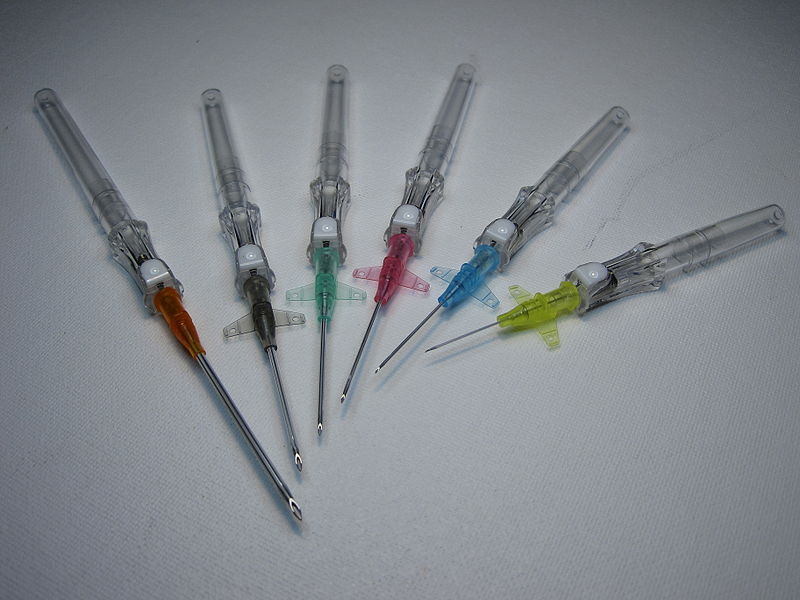
Nurses must ensure the selected size and type of IV catheter are appropriate for the procedure or infusion that is ordered because not all peripheral IV catheters are suitable for all procedures. For example, if a procedure requires the infusion of contrast dye, a specific size infusion port is required.
Despite the wide variation in catheter equipment that is available, there has been significant focus among manufacturers regarding the need for safety equipment during venipuncture. Many devices utilize mechanisms to self-contain needles within a plastic sheath after withdrawal from the patient. These devices can be activated through a button in the devices or a manual trigger initiated by the individual attempting cannulation. Regardless of the type of safety lock, it is important to utilize the equipment as intended and never attempt to disable or override the mechanism. These mechanisms are important to help prevent accidental needlesticks or injury with a contaminated needle after it has been removed from the patient. Additionally, after cannulation is attempted, the individual who attempted cannulation is responsible for ensuring all needles are disposed of in a sharps container. It is good practice to be aware of how many sharps were brought into the room, opened, and disposed. This helps to ensure that any needles are not inadvertently left in a patient's bed, tray table, floor, etc. Nurses must be familiar with the equipment used at the health care facility and receive orientation on the specific mechanics related to the equipment and safety practices.
Initiating Peripheral IV Access
The steps for initiating peripheral IV access are described in the Open RN Nursing Advanced Skills "Perform IV Insertion and IV Removal" checklist in Chapter 1.
Monitoring for Potential Complications
Several potential complications may arise from peripheral intravenous therapy. It is the responsibility of the nurse to prevent, assess, and manage signs and symptoms of complications. Complications can be categorized as local or systemic. See Table 23.4a for potential local complications of peripheral IV therapy.
Table 23.4a Local Complications of Peripheral IV Therapy[99],[100]
| Complications | Potential Causes and Prevention | Treatment |
|---|---|---|
| Phlebitis: The inflammation of the vein's inner lining, the tunica intima. Clinical indications are localized redness, pain, heat, purulent drainage, and swelling that can track up the vein leading to a palpable venous cord. | Mechanical causes: Inflammation of the vein's inner lining can be caused by the cannula rubbing and irritating the vein. To prevent mechanical inflammation, choose the smallest outer diameter of a catheter for therapy, secure the catheter with securement technology, avoid areas of flexion, and stabilize the joint as needed.[101]
Chemical causes: Inflammation of the vein's inner lining can be caused by medications or fluids with high alkaline, acidic, or hypertonic qualities. To avoid chemical phlebitis, follow the parenteral drug therapy guidelines in a drug reference resource for administering IV medications, including the appropriate amount of solution and rate of infusion. Infectious causes: May be related to emergent VAD insertions, poor aseptic technique, or contaminated dressings. |
Chemical phlebitis: Evaluate infusion therapy and the need for different vascular access, different medication, slower rate of infusion, or more dilute infusate. If indicated, remove the Vascular Access Device (VAD).[102]
Transient mechanical phlebitis: May be treatable by stabilizing the catheter, applying heat, elevating limb, and providing analgesics as needed. Consider requesting other pharmacologic interventions such as anti-inflammatory agents if needed. Monitor site for 24 hours post-insertion, and if signs and symptoms persist, remove the catheter.[103] Infectious phlebitis: If purulent drainage is present or infection is suspected, remove the catheter and obtain a culture of the purulent drainage and catheter tip. Monitor for signs of systemic infection.[104] |
| Infiltration: A condition that occurs when a nonvesicant solution is inadvertently administered into surrounding tissue. Signs and symptoms include pain, swelling, redness, the skin surrounding the insertion site is cool to touch, there is a change in the quality or flow of IV, the skin is tight around the IV site, IV fluid is leaking from IV site, or there are frequent alarms on the IV pump. | Infiltration is one of the most common complications in infusion therapy involving an IV catheter.[105] For this reason, the patency of an IV site must always be checked before administering IV push medications.
Infiltration can be caused by piercing the vein, excessive patient movement, a dislodged or incorrectly placed IV catheter, or too rapid infusion of fluids or medications into a fragile vein. Always secure a peripheral IV catheter with tape or a stabilization device to avoid accidental dislodgement. Avoid sites that are areas of flexion. |
Stop the infusion and remove the cannula. Follow agency policy related to infiltration. |
| Extravasation: A condition that occurs when vesicant (an irritating solution or medication) is administered and inadvertently leaks into surrounding tissue and causes damage. It is characterized by the same signs and symptoms as infiltration but also includes burning, stinging, redness, blistering, or necrosis of the tissue. | Extravasation has the same potential causes of infiltration but with worse consequences because of the effects of vesicants. Extravasation can result in severe tissue injury and death (necrosis). For this reason, known vesicant medications should be administered via central lines. | Stop the infusion. Detach all administration sets and aspirate from the catheter hub prior to removing the catheter to remove vesicant medication from the catheter lumen and as much as possible from the subcutaneous tissue.[106]
Follow agency policy regarding extravasation of specific medications. For example, toxic medications have a specific treatment plan. |
| Hemorrhage: Bleeding from the IV access site. | Bleeding occurs when the IV catheter becomes dislodged. | If dislodgement occurs, apply pressure with gauze to the site until the bleeding stops and then apply a sterile transparent dressing. |
| Local infection: Infection at the site is indicated by purulent drainage, typically two to three days after an IV site is started. | Local infection is often caused by nonadherence to aseptic technique during IV initiation or IV maintenance or the dressing becomes contaminated or non-intact over the access site. | Remove the cannula and clean the site using sterile technique. If infection is suspected, remove the catheter and obtain a culture of the purulent drainage and catheter tip. Monitor for signs of systemic infection. |
| Nerve injury[107] | Paresthesia-type pain occurring during venipuncture or during an indwelling IV catheter can indicate nerve injury. | Immediately remove the cannula, notify the provider, and document findings in the chart. |
In addition to local complications that can occur at the site of IV insertion, there are many systemic complications that nurses must monitor for when initiating peripheral IV access, as well as monitoring a patient receiving IV therapy. See Table 23.4b for a list of systemic complications, signs, symptoms, and treatment.
Table 23.4b Systemic Complications of Peripheral IV Therapy[108]
| Complication | Signs, Symptoms, and Treatment |
|---|---|
| Pulmonary Edema | Pulmonary edema, also known as fluid overload or circulatory overload, is a condition caused by excess fluid accumulation in the lungs due to excessive fluid in the circulatory system. It is characterized by decreased oxygen saturation; increased respiratory rate; fine or coarse crackles in the lung bases; restlessness; breathlessness; dyspnea; and coughing up pink, frothy sputum. Pulmonary edema requires prompt medical attention and treatment. If pulmonary edema is suspected, raise the head of the bed, apply oxygen, take vital signs, complete a cardiovascular assessment, and immediately notify the provider. |
| Air Embolism | An air embolism refers to the presence of air in the cardiovascular system. It occurs when air is introduced into the venous system and travels to the right ventricle and/or pulmonary circulation. Air embolisms can occur during catheter insertion, changing IV bags, adding secondary medication administration, and catheter removal. Inadvertent administration of 10 mL of air can have serious and fatal consequences. However, small air bubbles are tolerated by most patients. Signs and symptoms of an air embolism include sudden shortness of breath, continued coughing, breathlessness, shoulder or neck pain, agitation, feeling of impending doom, light-headedness, hypotension, wheezing, increased heart rate, altered mental status, and jugular venous distension.
If an air embolism is suspected, occlude the source of air entry. Place the patient in a Trendelenburg position on their left side (if not contraindicated), apply oxygen at 100%, obtain vital signs, and immediately notify the provider. To prevent air embolisms, perform the following steps when administering IV therapy: ensure the drip chamber is one-third to one-half filled, remove all air from the IV tubing by priming it prior to attaching it to the patient, use precautions when changing IV bags or adding secondary medication bags, ensure all IV connections are tight, and ensure clamps are used when the IV system is not in use. |
| Catheter Embolism | A catheter embolism occurs when a small part of the cannula breaks off and flows into the vascular system. When removing a peripheral IV cannula, inspect the catheter tip to ensure the end is intact. Notify the provider immediately if the catheter tip is not intact when it is removed. |
| Catheter-Related Bloodstream Infection (CR-BSI) | Catheter-related bloodstream infection (CR-BSI) is caused by microorganisms introduced into the bloodstream through the puncture site, the hub, or contaminated IV tubing or IV solution, leading to bacteremia or sepsis. A CR-BSI is a hospital-acquired preventable infection and considered an adverse event. A CR-BSI is diagnosed when infection occurs with one positive blood culture in a patient with a vascular device (or a patient who had a vascular device within 48 hours before the infection) with no apparent source for the infection other than the vascular access device. Treatment for CR-BSI is IV antibiotic therapy.
To prevent CR-BSI, it is vital to perform hand hygiene prior to care and maintenance of an IV system and to use strict aseptic technique for care and maintenance of all IV therapy procedures. |
Sample Documentation of Expected Findings
Initiated IV infusion of normal saline at 125 mL/hr using existing 22-gauge IV catheter located in the right hand. The IV site is free from pain, coolness, redness, or swelling.
Sample Documentation of Unexpected Findings
Attempted to initiate IV infusion in right hand with existing 22-gauge IV catheter. IV site free from pain, redness, or signs of infiltration. IV site flushed readily with normal saline. Normal saline IV fluids connected at 200 mL/hour with immediate leaking around infusion site. Swelling noted superior to infusion site. Fluids stopped immediately.
Catheter Size and Type Selection
Peripheral IV catheters are available in a variety of sizes, most commonly ranging from 14 gauge to 26 gauge. Note that the lower the gauge size, the wider the diameter of the catheter, with 14-gauge catheters allowing for the greatest flow rate.[109] Catheter sizes are color coded to allow for easy identification of the catheter size after a vein is accessed. See Figure 23.12[110] for colors associated with IV catheter sizes and their associated flow rates.

Nurses must consider the purpose for venous access, along with assessment of the patient's vessel size, when selecting an IV catheter to attempt cannulation. The smallest IV catheter should be selected that will accommodate the prescribed therapy and patient need.[111]
Catheters with a smaller gauge (i.e., larger diameter) permit infusion of viscous fluids, such as blood products, at a faster rate with decreased opportunity for catheter occlusion.[112] Additionally, an appropriately sized catheter also allows for adequate blood flow around the catheter itself. The most common IV catheter size for adult patients is 18- or 20-gauge catheters. However, frail elderly patients and children have smaller vasculature, so a 22-gauge catheter is often preferred.
There are different manufacturer brands of IV catheters, but all include a beveled hollow needle, a flashback chamber in which blood can be visualized when entering the vein, and a flexible catheter that is left in the vein after the catheter has been threaded into the vein and the needle removed.
IV insertion equipment varies among institutions, but common types include shielded IV catheters or winged (i.e., "butterfly") devices. Variation is often related to the presence of a stabilizing device at the site of insertion, as well as the presence of short extension tubing. For shielded catheter types, the stabilizing device and extension tubing are typically added to the catheter itself and not included with the cannulation needle. See Figure 23.13[113] for an image of shielded IV catheters.

Nurses must ensure the selected size and type of IV catheter are appropriate for the procedure or infusion that is ordered because not all peripheral IV catheters are suitable for all procedures. For example, if a procedure requires the infusion of contrast dye, a specific size infusion port is required.
Despite the wide variation in catheter equipment that is available, there has been significant focus among manufacturers regarding the need for safety equipment during venipuncture. Many devices utilize mechanisms to self-contain needles within a plastic sheath after withdrawal from the patient. These devices can be activated through a button in the devices or a manual trigger initiated by the individual attempting cannulation. Regardless of the type of safety lock, it is important to utilize the equipment as intended and never attempt to disable or override the mechanism. These mechanisms are important to help prevent accidental needlesticks or injury with a contaminated needle after it has been removed from the patient. Additionally, after cannulation is attempted, the individual who attempted cannulation is responsible for ensuring all needles are disposed of in a sharps container. It is good practice to be aware of how many sharps were brought into the room, opened, and disposed. This helps to ensure that any needles are not inadvertently left in a patient's bed, tray table, floor, etc. Nurses must be familiar with the equipment used at the health care facility and receive orientation on the specific mechanics related to the equipment and safety practices.
Initiating Peripheral IV Access
The steps for initiating peripheral IV access are described in the Open RN Nursing Advanced Skills "Perform IV Insertion and IV Removal" checklist in Chapter 1.
Monitoring for Potential Complications
Several potential complications may arise from peripheral intravenous therapy. It is the responsibility of the nurse to prevent, assess, and manage signs and symptoms of complications. Complications can be categorized as local or systemic. See Table 23.4a for potential local complications of peripheral IV therapy.
Table 23.4a Local Complications of Peripheral IV Therapy[114],[115]
| Complications | Potential Causes and Prevention | Treatment |
|---|---|---|
| Phlebitis: The inflammation of the vein's inner lining, the tunica intima. Clinical indications are localized redness, pain, heat, purulent drainage, and swelling that can track up the vein leading to a palpable venous cord. | Mechanical causes: Inflammation of the vein's inner lining can be caused by the cannula rubbing and irritating the vein. To prevent mechanical inflammation, choose the smallest outer diameter of a catheter for therapy, secure the catheter with securement technology, avoid areas of flexion, and stabilize the joint as needed.[116]
Chemical causes: Inflammation of the vein's inner lining can be caused by medications or fluids with high alkaline, acidic, or hypertonic qualities. To avoid chemical phlebitis, follow the parenteral drug therapy guidelines in a drug reference resource for administering IV medications, including the appropriate amount of solution and rate of infusion. Infectious causes: May be related to emergent VAD insertions, poor aseptic technique, or contaminated dressings. |
Chemical phlebitis: Evaluate infusion therapy and the need for different vascular access, different medication, slower rate of infusion, or more dilute infusate. If indicated, remove the Vascular Access Device (VAD).[117]
Transient mechanical phlebitis: May be treatable by stabilizing the catheter, applying heat, elevating limb, and providing analgesics as needed. Consider requesting other pharmacologic interventions such as anti-inflammatory agents if needed. Monitor site for 24 hours post-insertion, and if signs and symptoms persist, remove the catheter.[118] Infectious phlebitis: If purulent drainage is present or infection is suspected, remove the catheter and obtain a culture of the purulent drainage and catheter tip. Monitor for signs of systemic infection.[119] |
| Infiltration: A condition that occurs when a nonvesicant solution is inadvertently administered into surrounding tissue. Signs and symptoms include pain, swelling, redness, the skin surrounding the insertion site is cool to touch, there is a change in the quality or flow of IV, the skin is tight around the IV site, IV fluid is leaking from IV site, or there are frequent alarms on the IV pump. | Infiltration is one of the most common complications in infusion therapy involving an IV catheter.[120] For this reason, the patency of an IV site must always be checked before administering IV push medications.
Infiltration can be caused by piercing the vein, excessive patient movement, a dislodged or incorrectly placed IV catheter, or too rapid infusion of fluids or medications into a fragile vein. Always secure a peripheral IV catheter with tape or a stabilization device to avoid accidental dislodgement. Avoid sites that are areas of flexion. |
Stop the infusion and remove the cannula. Follow agency policy related to infiltration. |
| Extravasation: A condition that occurs when vesicant (an irritating solution or medication) is administered and inadvertently leaks into surrounding tissue and causes damage. It is characterized by the same signs and symptoms as infiltration but also includes burning, stinging, redness, blistering, or necrosis of the tissue. | Extravasation has the same potential causes of infiltration but with worse consequences because of the effects of vesicants. Extravasation can result in severe tissue injury and death (necrosis). For this reason, known vesicant medications should be administered via central lines. | Stop the infusion. Detach all administration sets and aspirate from the catheter hub prior to removing the catheter to remove vesicant medication from the catheter lumen and as much as possible from the subcutaneous tissue.[121]
Follow agency policy regarding extravasation of specific medications. For example, toxic medications have a specific treatment plan. |
| Hemorrhage: Bleeding from the IV access site. | Bleeding occurs when the IV catheter becomes dislodged. | If dislodgement occurs, apply pressure with gauze to the site until the bleeding stops and then apply a sterile transparent dressing. |
| Local infection: Infection at the site is indicated by purulent drainage, typically two to three days after an IV site is started. | Local infection is often caused by nonadherence to aseptic technique during IV initiation or IV maintenance or the dressing becomes contaminated or non-intact over the access site. | Remove the cannula and clean the site using sterile technique. If infection is suspected, remove the catheter and obtain a culture of the purulent drainage and catheter tip. Monitor for signs of systemic infection. |
| Nerve injury[122] | Paresthesia-type pain occurring during venipuncture or during an indwelling IV catheter can indicate nerve injury. | Immediately remove the cannula, notify the provider, and document findings in the chart. |
In addition to local complications that can occur at the site of IV insertion, there are many systemic complications that nurses must monitor for when initiating peripheral IV access, as well as monitoring a patient receiving IV therapy. See Table 23.4b for a list of systemic complications, signs, symptoms, and treatment.
Table 23.4b Systemic Complications of Peripheral IV Therapy[123]
| Complication | Signs, Symptoms, and Treatment |
|---|---|
| Pulmonary Edema | Pulmonary edema, also known as fluid overload or circulatory overload, is a condition caused by excess fluid accumulation in the lungs due to excessive fluid in the circulatory system. It is characterized by decreased oxygen saturation; increased respiratory rate; fine or coarse crackles in the lung bases; restlessness; breathlessness; dyspnea; and coughing up pink, frothy sputum. Pulmonary edema requires prompt medical attention and treatment. If pulmonary edema is suspected, raise the head of the bed, apply oxygen, take vital signs, complete a cardiovascular assessment, and immediately notify the provider. |
| Air Embolism | An air embolism refers to the presence of air in the cardiovascular system. It occurs when air is introduced into the venous system and travels to the right ventricle and/or pulmonary circulation. Air embolisms can occur during catheter insertion, changing IV bags, adding secondary medication administration, and catheter removal. Inadvertent administration of 10 mL of air can have serious and fatal consequences. However, small air bubbles are tolerated by most patients. Signs and symptoms of an air embolism include sudden shortness of breath, continued coughing, breathlessness, shoulder or neck pain, agitation, feeling of impending doom, light-headedness, hypotension, wheezing, increased heart rate, altered mental status, and jugular venous distension.
If an air embolism is suspected, occlude the source of air entry. Place the patient in a Trendelenburg position on their left side (if not contraindicated), apply oxygen at 100%, obtain vital signs, and immediately notify the provider. To prevent air embolisms, perform the following steps when administering IV therapy: ensure the drip chamber is one-third to one-half filled, remove all air from the IV tubing by priming it prior to attaching it to the patient, use precautions when changing IV bags or adding secondary medication bags, ensure all IV connections are tight, and ensure clamps are used when the IV system is not in use. |
| Catheter Embolism | A catheter embolism occurs when a small part of the cannula breaks off and flows into the vascular system. When removing a peripheral IV cannula, inspect the catheter tip to ensure the end is intact. Notify the provider immediately if the catheter tip is not intact when it is removed. |
| Catheter-Related Bloodstream Infection (CR-BSI) | Catheter-related bloodstream infection (CR-BSI) is caused by microorganisms introduced into the bloodstream through the puncture site, the hub, or contaminated IV tubing or IV solution, leading to bacteremia or sepsis. A CR-BSI is a hospital-acquired preventable infection and considered an adverse event. A CR-BSI is diagnosed when infection occurs with one positive blood culture in a patient with a vascular device (or a patient who had a vascular device within 48 hours before the infection) with no apparent source for the infection other than the vascular access device. Treatment for CR-BSI is IV antibiotic therapy.
To prevent CR-BSI, it is vital to perform hand hygiene prior to care and maintenance of an IV system and to use strict aseptic technique for care and maintenance of all IV therapy procedures. |
Sample Documentation of Expected Findings
Initiated IV infusion of normal saline at 125 mL/hr using existing 22-gauge IV catheter located in the right hand. The IV site is free from pain, coolness, redness, or swelling.
Sample Documentation of Unexpected Findings
Attempted to initiate IV infusion in right hand with existing 22-gauge IV catheter. IV site free from pain, redness, or signs of infiltration. IV site flushed readily with normal saline. Normal saline IV fluids connected at 200 mL/hour with immediate leaking around infusion site. Swelling noted superior to infusion site. Fluids stopped immediately.
Use the checklist below to review the steps for completion of “Primary IV Solution Administration.” Review the steps to safely administer all types of medication in the "Checklist for Oral Medication Administration" in the "Administration of Enteral Medications" chapter.
View an instructor demonstration of Primary IV Solution Administration[124]:
Steps
Disclaimer: Always review and follow agency policy regarding this specific skill.
- Gather supplies: IV fluid, primary tubing, tubing change label, and alcohol pads/scrub hubs.
- Verify the provider order with the medication administration record (eMAR/MAR).
- Perform the first check of the six rights of medication administration while withdrawing the IV fluids from the medication dispensing unit. Check expiration date and verify patient allergies.
- Remove the IV solution from the packaging and gently apply pressure to the bag while inspecting for tears or leaks.
- Check the color and clarity of the solution.
- Perform the second check of the six rights of medication administration.
- Perform safety steps:
- Perform hand hygiene.
- Check the room for transmission-based precautions.
- Introduce yourself, your role, the purpose of your visit, and an estimate of the time it will take.
- Confirm patient ID using two patient identifiers (e.g., name and date of birth).
- Explain the process to the patient and ask if they have any questions.
- Be organized and systematic.
- Use appropriate listening and questioning skills.
- Listen and attend to patient cues.
- Ensure the patient’s privacy and dignity.
- Assess ABCs (airway, breathing, and circulation).
- Perform the third check of the rights of medication administration at the patient's bedside.
- Remove the primary IV tubing from the packaging. If administering IV fluid by gravity, note the drip factor on the package and calculate drops/min. Perform the necessary calculations for the infusion rate.
- Move the roller clamp so that it is halfway up the tubing and clamp it.
- Remove the cover from the tubing port on the bag of IV fluid.
- Remove the cap from the insertion spike on the tubing. While maintaining sterility, insert the spike into the tubing port of the bag of IV fluid.
- Squeeze the drip chamber two or three times to fill the chamber halfway.
- Loosen the cap from the end of the IV tubing and open the clamp to prime the tubing over the sink:
- If using multiple port tubing, invert the ports to prime them and to prevent air accumulation in line.
- If the solution is an antibiotic, take care to not waste solution while priming the tubing to ensure the patient receives the correct dosage.
- Once primed, clamp the IV tubing and check the entire length of the tubing for air bubbles. Tap the tubing gently to remove any air.
- Replace or tighten the cap on the end of the tubing.
- Label the primary IV fluid bag with the date and time. Place the tubing label on the tubing near the drip chamber.
- Assess the patient’s venipuncture site for signs and symptoms of vein irritation or infiltration. Do not proceed with administering fluids at this site if there are any concerns.
- Based on agency policy, vigorously cleanse the catheter cap on the patient's IV port with an alcohol pad/scrub hub (or the agency required cleansing agent) for at least fifteen seconds and allow it to dry.[125]
- Assess IV site patency according to agency policy. Purge a prefilled normal saline syringe of air. Attach the syringe onto the saline lock cap. Undo the clamp on the extension tubing. Inject 3 to 5 mL of normal saline using a turbulent stop-start technique. If resistance is felt, do not force the flush and do not proceed with IV solution administration; follow up according to agency policy.
- Remove the syringe from the IV cap and then clamp the extension tubing.
- Vigorously cleanse the catheter cap on the patient's IV port with an alcohol pad/scrub hub (or the agency required cleansing agent) for at least five seconds and allow it to dry.
- Remove the protective cap from the end of the primary tubing and attach it to the IV port while maintaining sterility.
- Move the slide clamp on the saline lock to open the tubing.
- Set the infusion rate based on the provider order:
- For infusion pump: Set volume to be infused and rate (mL/hr) to be administered.
- For gravity: Calculate drop per minute.
- Assess the patient’s IV site for signs and symptoms of vein irritation or infiltration after infusion begins.
- Secure the tubing to the patient’s arm.
- Assist the patient to a comfortable position, ask if they have any questions, and thank them for their time.
- Ensure safety measures when leaving the room:
- CALL LIGHT: Within reach
- BED: Low and locked (in lowest position and brakes on)
- SIDE RAILS: Secured
- TABLE: Within reach
- ROOM: Risk-free for falls (scan room and clear any obstacles)
- Perform hand hygiene.
- Document the procedure and related assessment findings. Report any concerns according to agency policy. Include IV fluids on patient's input/output documentation.
Use the checklist below to review the steps for completion of “Primary IV Solution Administration.” Review the steps to safely administer all types of medication in the "Checklist for Oral Medication Administration" in the "Administration of Enteral Medications" chapter.
View an instructor demonstration of Primary IV Solution Administration[126]:
Steps
Disclaimer: Always review and follow agency policy regarding this specific skill.
- Gather supplies: IV fluid, primary tubing, tubing change label, and alcohol pads/scrub hubs.
- Verify the provider order with the medication administration record (eMAR/MAR).
- Perform the first check of the six rights of medication administration while withdrawing the IV fluids from the medication dispensing unit. Check expiration date and verify patient allergies.
- Remove the IV solution from the packaging and gently apply pressure to the bag while inspecting for tears or leaks.
- Check the color and clarity of the solution.
- Perform the second check of the six rights of medication administration.
- Perform safety steps:
- Perform hand hygiene.
- Check the room for transmission-based precautions.
- Introduce yourself, your role, the purpose of your visit, and an estimate of the time it will take.
- Confirm patient ID using two patient identifiers (e.g., name and date of birth).
- Explain the process to the patient and ask if they have any questions.
- Be organized and systematic.
- Use appropriate listening and questioning skills.
- Listen and attend to patient cues.
- Ensure the patient’s privacy and dignity.
- Assess ABCs (airway, breathing, and circulation).
- Perform the third check of the rights of medication administration at the patient's bedside.
- Remove the primary IV tubing from the packaging. If administering IV fluid by gravity, note the drip factor on the package and calculate drops/min. Perform the necessary calculations for the infusion rate.
- Move the roller clamp so that it is halfway up the tubing and clamp it.
- Remove the cover from the tubing port on the bag of IV fluid.
- Remove the cap from the insertion spike on the tubing. While maintaining sterility, insert the spike into the tubing port of the bag of IV fluid.
- Squeeze the drip chamber two or three times to fill the chamber halfway.
- Loosen the cap from the end of the IV tubing and open the clamp to prime the tubing over the sink:
- If using multiple port tubing, invert the ports to prime them and to prevent air accumulation in line.
- If the solution is an antibiotic, take care to not waste solution while priming the tubing to ensure the patient receives the correct dosage.
- Once primed, clamp the IV tubing and check the entire length of the tubing for air bubbles. Tap the tubing gently to remove any air.
- Replace or tighten the cap on the end of the tubing.
- Label the primary IV fluid bag with the date and time. Place the tubing label on the tubing near the drip chamber.
- Assess the patient’s venipuncture site for signs and symptoms of vein irritation or infiltration. Do not proceed with administering fluids at this site if there are any concerns.
- Based on agency policy, vigorously cleanse the catheter cap on the patient's IV port with an alcohol pad/scrub hub (or the agency required cleansing agent) for at least fifteen seconds and allow it to dry.[127]
- Assess IV site patency according to agency policy. Purge a prefilled normal saline syringe of air. Attach the syringe onto the saline lock cap. Undo the clamp on the extension tubing. Inject 3 to 5 mL of normal saline using a turbulent stop-start technique. If resistance is felt, do not force the flush and do not proceed with IV solution administration; follow up according to agency policy.
- Remove the syringe from the IV cap and then clamp the extension tubing.
- Vigorously cleanse the catheter cap on the patient's IV port with an alcohol pad/scrub hub (or the agency required cleansing agent) for at least five seconds and allow it to dry.
- Remove the protective cap from the end of the primary tubing and attach it to the IV port while maintaining sterility.
- Move the slide clamp on the saline lock to open the tubing.
- Set the infusion rate based on the provider order:
- For infusion pump: Set volume to be infused and rate (mL/hr) to be administered.
- For gravity: Calculate drop per minute.
- Assess the patient’s IV site for signs and symptoms of vein irritation or infiltration after infusion begins.
- Secure the tubing to the patient’s arm.
- Assist the patient to a comfortable position, ask if they have any questions, and thank them for their time.
- Ensure safety measures when leaving the room:
- CALL LIGHT: Within reach
- BED: Low and locked (in lowest position and brakes on)
- SIDE RAILS: Secured
- TABLE: Within reach
- ROOM: Risk-free for falls (scan room and clear any obstacles)
- Perform hand hygiene.
- Document the procedure and related assessment findings. Report any concerns according to agency policy. Include IV fluids on patient's input/output documentation.
Use the checklist below to review the steps for completion of “Secondary IV Solution Administration.” This checklist is used when fluids are already being administered via the primary IV tubing and a second IV solution is administered.
View an instructor demonstration of Secondary IV Solution Administration[128]:
Steps
Disclaimer: Always review and follow agency policy regarding this specific skill.
- Gather supplies: secondary IV fluid/medication, secondary IV tubing, alcohol wipe/scrub hubs, and tubing labels.
- Verify the provider order with the medication administration record (eMAR/MAR).
- Perform the first check of the rights of medication administration while withdrawing the IV solution and tubing from the medication dispensing unit. Check expiration dates on the fluid and the tubing and verify allergies.
- Verify compatibility of the secondary IV solution with the other IV fluids the patient is currently receiving.
- Remove the IV solution from the packaging and gently apply pressure to the bag while inspecting for tears or leaks. Check the color and clarity of the solution.
- Perform the second check of the rights of medication administration.
- Perform safety steps:
- Perform hand hygiene.
- Check the room for transmission-based precautions.
- Introduce yourself, your role, the purpose of your visit, and an estimate of the time it will take.
- Confirm patient ID using two patient identifiers (e.g., name and date of birth).
- Explain the process to the patient and ask if they have any questions.
- Be organized and systematic.
- Use appropriate listening and questioning skills.
- Listen and attend to patient cues.
- Ensure the patient’s privacy and dignity.
- Assess ABCs (airway, breathing, circulation).
- Perform the third check of the rights of medication administration at the patient's bedside.
- If the patient is receiving the medication for the first time, teach the patient and family (if appropriate) about the potential adverse reactions and other concerns related to the medication.
- Remove the secondary IV tubing from the packaging.
- Place the roller clamp to the “off” position.
- Remove the protective sheath from the IV spike and the cover from the tubing port of the IV solution.
- Insert the spike into the IV bag while maintaining sterility.
- Prime the secondary IV tubing. Back priming is considered best practice and is performed using an infusion pump or gravity with primary fluids attached:
- Vigorously cleanse the Y port closest to the drip chamber with an alcohol pad/scrub hub (or the agency required cleansing agent) for at least five seconds and allow it to dry.
- Connect the secondary tubing to the port closest to the drip chamber. Lower the secondary bag below the primary bag and allow the fluid from the primary bag to fill the secondary tubing. Fill the secondary tubing until it reaches the drip chamber, and then raise the secondary bag above the primary line.
- Hang the secondary IV solution on the IV pole with the primary bag lower than the secondary bag.
- Label the secondary tubing near the drip chamber.
- Set the infusion rate:
- For infusion pump: Set the volume to be infused and the rate (mL/hr) to be administered based on the provider order.
- For gravity: The roller clamp on the secondary tubing will be opened completely, and the roller clamp on the primary tubing will be adjusted to deliver the prescribed rate.
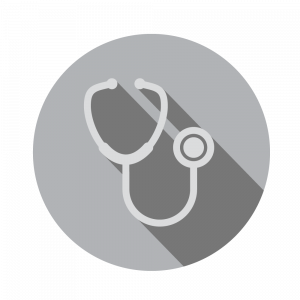 Take time to watch the IV fluid or medication to drip into the drip chamber to ensure the medication or fluid is flowing to the patient.
Take time to watch the IV fluid or medication to drip into the drip chamber to ensure the medication or fluid is flowing to the patient. - Assess the patient’s IV site for signs and symptoms of vein irritation or infiltration after infusion begins. Do not proceed with administering secondary fluids if there are any concerns about the site.
- Assist the patient to a comfortable position, ask if they have any questions, and thank them for their time.
- Ensure safety measures when leaving the room:
- CALL LIGHT: Within reach
- BED: Low and locked (in lowest position and brakes on)
- SIDE RAILS: Secured
- TABLE: Within reach
- ROOM: Risk-free for falls (scan room and clear any obstacles)
- Perform hand hygiene.
- Document the procedure and assessment findings. Report any concerns according to agency policy.
Use the checklist below to review the steps for completion of “Secondary IV Solution Administration.” This checklist is used when fluids are already being administered via the primary IV tubing and a second IV solution is administered.
View an instructor demonstration of Secondary IV Solution Administration[129]:
Steps
Disclaimer: Always review and follow agency policy regarding this specific skill.
- Gather supplies: secondary IV fluid/medication, secondary IV tubing, alcohol wipe/scrub hubs, and tubing labels.
- Verify the provider order with the medication administration record (eMAR/MAR).
- Perform the first check of the rights of medication administration while withdrawing the IV solution and tubing from the medication dispensing unit. Check expiration dates on the fluid and the tubing and verify allergies.
- Verify compatibility of the secondary IV solution with the other IV fluids the patient is currently receiving.
- Remove the IV solution from the packaging and gently apply pressure to the bag while inspecting for tears or leaks. Check the color and clarity of the solution.
- Perform the second check of the rights of medication administration.
- Perform safety steps:
- Perform hand hygiene.
- Check the room for transmission-based precautions.
- Introduce yourself, your role, the purpose of your visit, and an estimate of the time it will take.
- Confirm patient ID using two patient identifiers (e.g., name and date of birth).
- Explain the process to the patient and ask if they have any questions.
- Be organized and systematic.
- Use appropriate listening and questioning skills.
- Listen and attend to patient cues.
- Ensure the patient’s privacy and dignity.
- Assess ABCs (airway, breathing, circulation).
- Perform the third check of the rights of medication administration at the patient's bedside.
- If the patient is receiving the medication for the first time, teach the patient and family (if appropriate) about the potential adverse reactions and other concerns related to the medication.
- Remove the secondary IV tubing from the packaging.
- Place the roller clamp to the “off” position.
- Remove the protective sheath from the IV spike and the cover from the tubing port of the IV solution.
- Insert the spike into the IV bag while maintaining sterility.
- Prime the secondary IV tubing. Back priming is considered best practice and is performed using an infusion pump or gravity with primary fluids attached:
- Vigorously cleanse the Y port closest to the drip chamber with an alcohol pad/scrub hub (or the agency required cleansing agent) for at least five seconds and allow it to dry.
- Connect the secondary tubing to the port closest to the drip chamber. Lower the secondary bag below the primary bag and allow the fluid from the primary bag to fill the secondary tubing. Fill the secondary tubing until it reaches the drip chamber, and then raise the secondary bag above the primary line.
- Hang the secondary IV solution on the IV pole with the primary bag lower than the secondary bag.
- Label the secondary tubing near the drip chamber.
- Set the infusion rate:
- For infusion pump: Set the volume to be infused and the rate (mL/hr) to be administered based on the provider order.
- For gravity: The roller clamp on the secondary tubing will be opened completely, and the roller clamp on the primary tubing will be adjusted to deliver the prescribed rate.
 Take time to watch the IV fluid or medication to drip into the drip chamber to ensure the medication or fluid is flowing to the patient.
Take time to watch the IV fluid or medication to drip into the drip chamber to ensure the medication or fluid is flowing to the patient. - Assess the patient’s IV site for signs and symptoms of vein irritation or infiltration after infusion begins. Do not proceed with administering secondary fluids if there are any concerns about the site.
- Assist the patient to a comfortable position, ask if they have any questions, and thank them for their time.
- Ensure safety measures when leaving the room:
- CALL LIGHT: Within reach
- BED: Low and locked (in lowest position and brakes on)
- SIDE RAILS: Secured
- TABLE: Within reach
- ROOM: Risk-free for falls (scan room and clear any obstacles)
- Perform hand hygiene.
- Document the procedure and assessment findings. Report any concerns according to agency policy.
Sample Documentation of Expected Findings
IV catheter on right hand discontinued with catheter tip intact. Site free from redness, warmth, tenderness, or swelling. Gauze applied with pressure for one minute with no bleeding noted. Dressing applied to site.
Sample Documentation of Unexpected Findings
IV catheter on right hand discontinued with IV catheter tip intact. Site free from redness, warmth, tenderness, or swelling. Gauze applied with pressure for one minute. Bleeding noted to continue around gauze dressing. Pressure held for five minutes, and hemostasis achieved. Dressing applied to site.
Sample Documentation of Expected Findings
IV catheter on right hand discontinued with catheter tip intact. Site free from redness, warmth, tenderness, or swelling. Gauze applied with pressure for one minute with no bleeding noted. Dressing applied to site.
Sample Documentation of Unexpected Findings
IV catheter on right hand discontinued with IV catheter tip intact. Site free from redness, warmth, tenderness, or swelling. Gauze applied with pressure for one minute. Bleeding noted to continue around gauze dressing. Pressure held for five minutes, and hemostasis achieved. Dressing applied to site.

